Vol. 68, No. 23 (2019)
2019-12-05
GENERAL
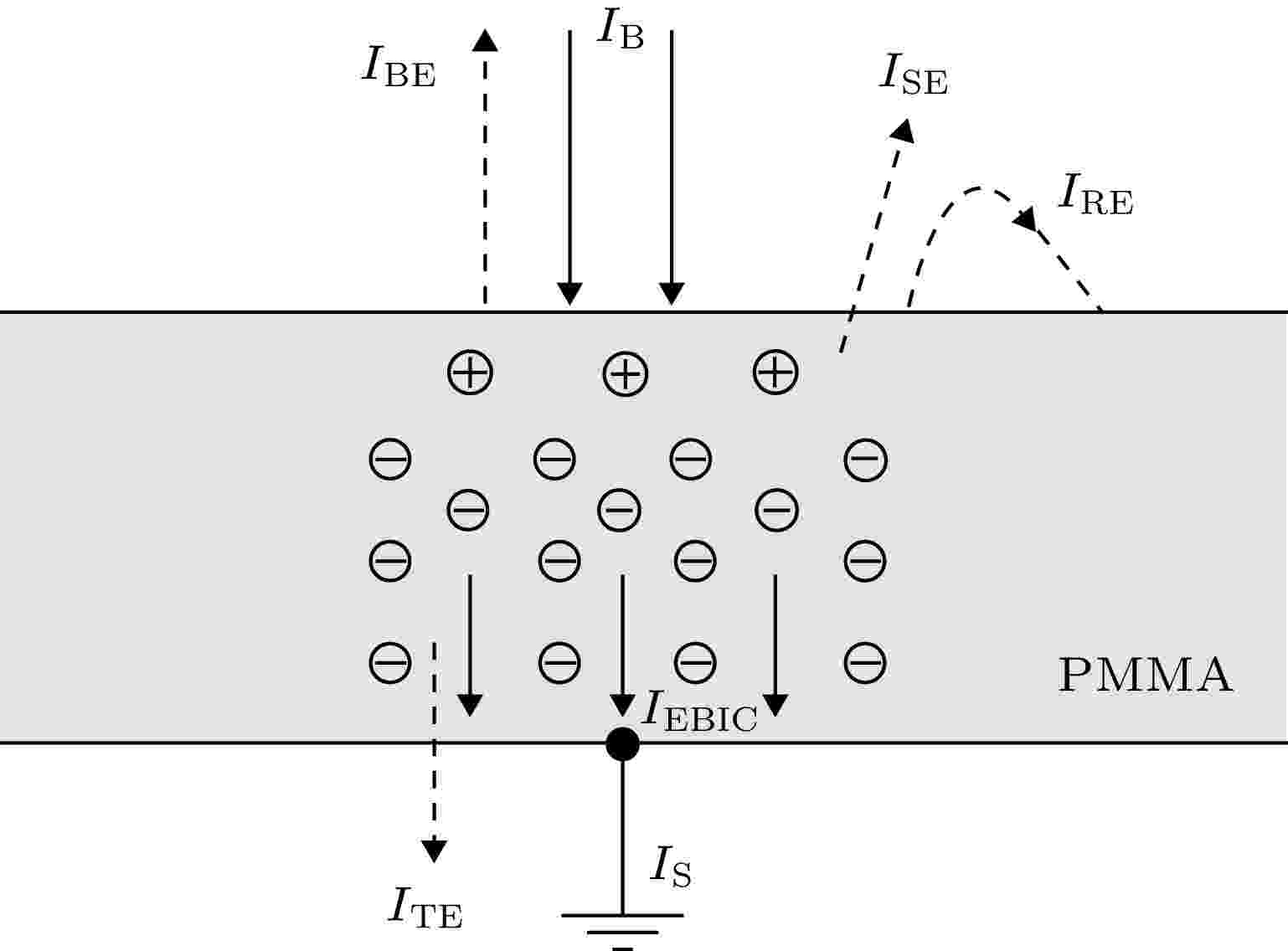
2019, 68 (23): 230201.
doi: 10.7498/aps.68.20191112
Abstract +
The serious charging effect of polymer film with a thickness of the order of microns under the radiation of high-energy transmission electron beam, on the reliability of the micro-nano electronic device in electron microscopy detection is investigated. The charging effect of the polymer film is numerically calculated in this paper. The scattering process is simulated by the Monte Carlo method. The elastic scattering is calculated with the Rutherford scattering model. The inelastic scattering is simulated with the fast secondary electron (SE) model and the Penn model. The transport, the capture, and the recombination process of the charges are treated with the finite difference method. The fourth-order Runge-Kutta method is used to solve the trajectory of the emitted SEs. The dynamic distributions of the net charge, the built-in electric field, the surface emission current, and the transmission current are investigated, and the influence of the film thickness and the beam energy on the charging characteristics are analyzed. The results show that due to the emission of electrons near the sample surface, the distribution of the net charge in the sample is first positive and then negative along the incident direction. In addition, under the irradiation,higher charge quantity is deposited in the sample, and the net charge density increases gradually. However, with long-time irradiation, the deposited electrons transport to the surface under the action of built-in electric field which reduces the surface net charge density. Therefore the net charge density tends to a stable value. The space potential is positive in the surface and negative inside the sample. Therefore some emitted SEs return to the surface, resulting in the electron beam-induced current. With the irradiation, the positive surface potential increases and tends to a stable value. Hence the actual surface emission current decreases to a stable value and the sample current increases to a stable value. The sample current remains unchanged due to the weak charging strength. Increasing the film thickness leads the transient time to increase, which contributes to the decline of the surface potential and the increase of the actual emission currentand sample current. The increase of the beam energy causes the transmission current to increase and the sample current to decrease. In addition, it reduces the positive surface potential and the actual surface emission current accordingly. The results conduce to the decrease of the charging effect of the polymer film under the radiation of high-energy electron beam in the electron microscopy.
2019, 68 (23): 230301.
doi: 10.7498/aps.68.20190966
Abstract +
The theory of quantum coherence is an important kind of quantum resource theory, and its free operations are various kinds of incoherent operations. In the single-system coherence resource theory, the maximally coherent state is the most important quantum resource state, and it can turn into a quantum state of any other pure state. However, the situation is quite different from multipartite quantum systems: not only does no-go theorem forbidding the existence of a unique maximally coherent state exist there, but almost all pure multipartite coherent states are incomparable (i.e., some incoherent operation transformations among them are almost never possible). In order to cope with this problem, we consider general coherent resource theories in which we relax the traditional incoherent operations to operations that do not create coherence. Specifically, we consider two possible theories, depending on whether resources correspond to bipartite coherence or genuinely multipartite coherent states (each subsystem is coherent): one is the theory in which bipartite coherence states are considered as a resource and the free operations are bipartite incoherent preservation and the other is the theory that involves genuinely multipartite coherent states and fully incoherent operations. These ideas come from the research by Contreras-Tejada et al. (Phys. Rev. Lett. 122 120503), where the alternative entanglement resource theories were considered through relaxing the class of local operations and classical communication (LOCC) to operations that do not create entanglement, and they considered two possible theories depending on whether resources correspond to the multipartite entangled or genuinely multipartite entangled (GME) states. Furthermore, we show that there exists meaningful partial order (i.e. each pure state is transformable to a more weakly coherent pure state) in these two theory frames. Finally, we prove that the genuine multipartite coherent resource theory has a unique maximally coherent state (i.e. it can be transformed into any other state by the allowed free operations). Our results cover a wide class of coherent resource theories due to the free operations we introduced, and the discussion is solidified by important examples, such as entanglement, superposition, asymmetry, et al. And, how to establish the relations between these two kinds of multipartite coherent states, quantum discords and entanglements is also an interesting problem.
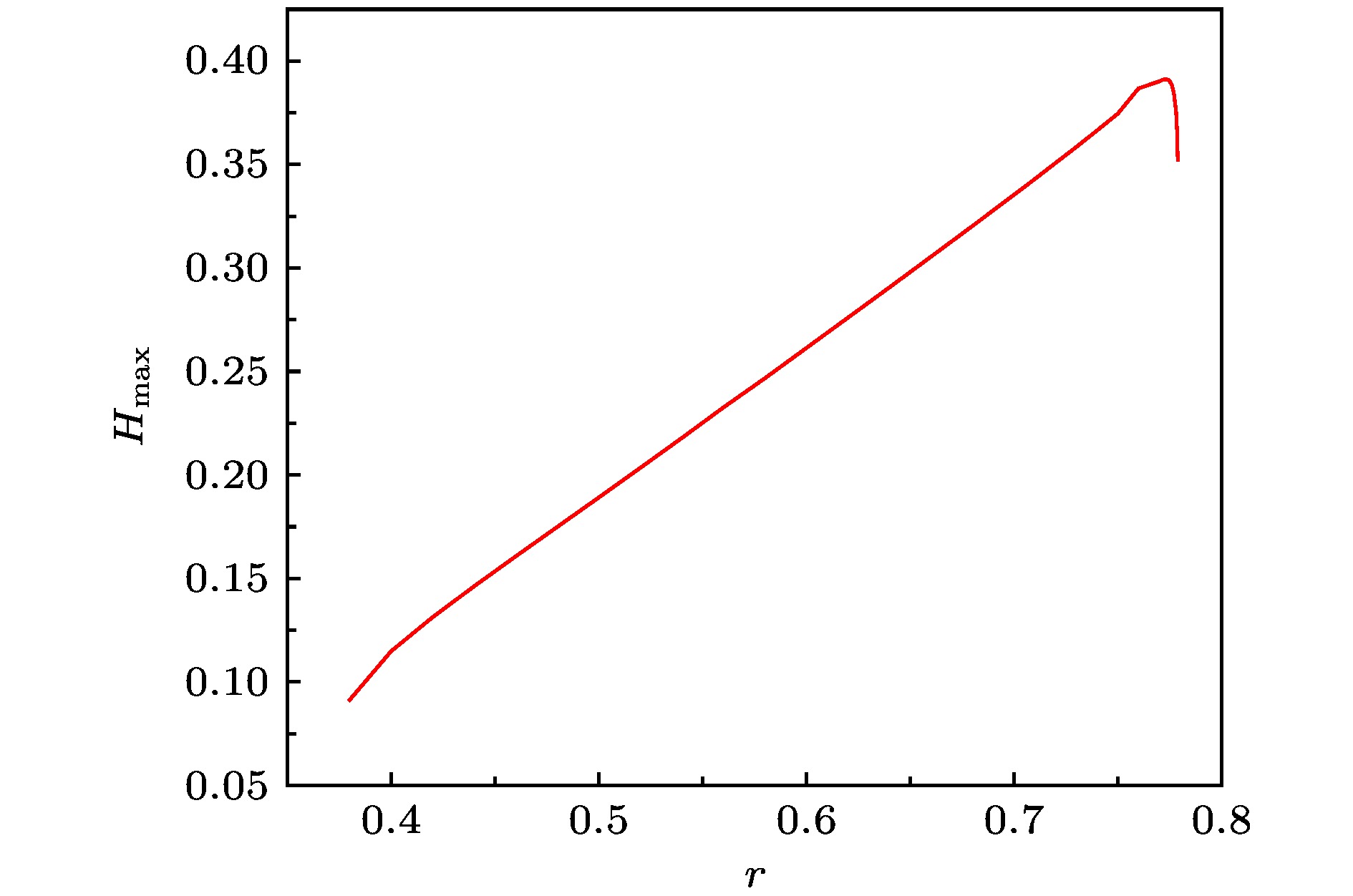
2019, 68 (23): 230302.
doi: 10.7498/aps.68.20191125
Abstract +
Quantum nonlocality is an important phenomenon predicted by quantum mechanics. It is also one of the most important characteristics that quantum theory is different from classical theory. Therefore, it is of great significance to test the quantum nonlocality with higher successful probability. In this paper, a testing logic based on Hardy-type paradox is proposed and its applicability is proved. Such a logic can be used to test the quantum nonlocality for both the quantum mixed state and the quantum pure state with a high successful probability. It is found that, for quantum pure states, the probability of successfully testing the quantum nonlocality first increases and then decreases with the increase of entanglement degree of quantum states. The maximum successful probability of the testing the quantum pure state is over 39%. Furthermore, taking the Werner-like state, a quantum mixed state for example, the high successful probability of testing the quantum nonlocality is investigated by using the proposed logic. It is found that with the increase of the purity of the quantum mixed state, the successful probability of testing the quantum nonlocal correlation will increase. Finally, the conditions and the range of testing quantum nonlocality with high successful probability for Werner states are given. It is found that for r = 0.599997, the Werner-like quantum mixed state has a maximum range (i.e. ${\rm Tr}({{\rho}^2}) \geqslant 0.874696$ ) of successfully testing the quantum nonlocality.
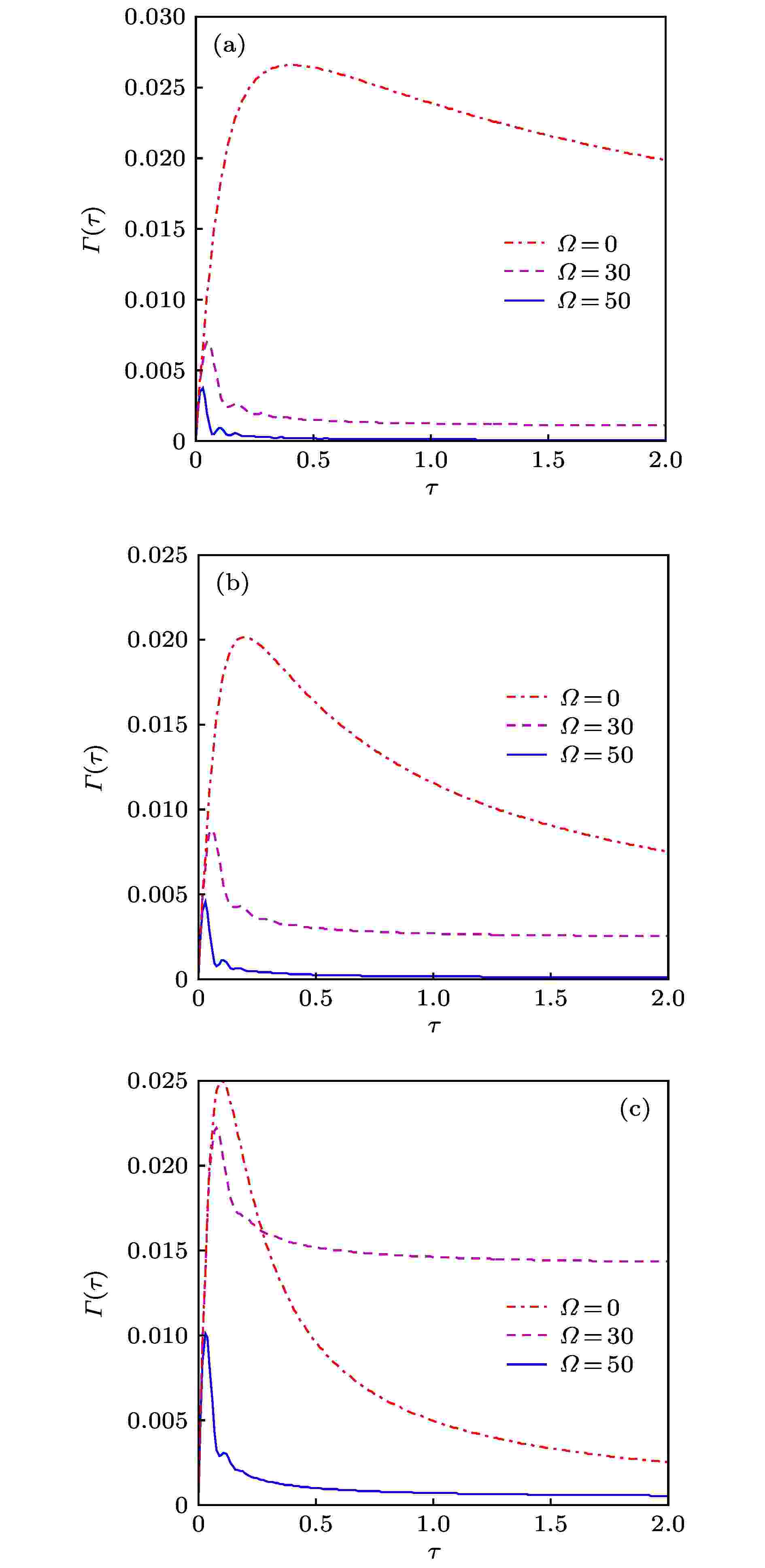
2019, 68 (23): 230303.
doi: 10.7498/aps.68.20191078
Abstract +
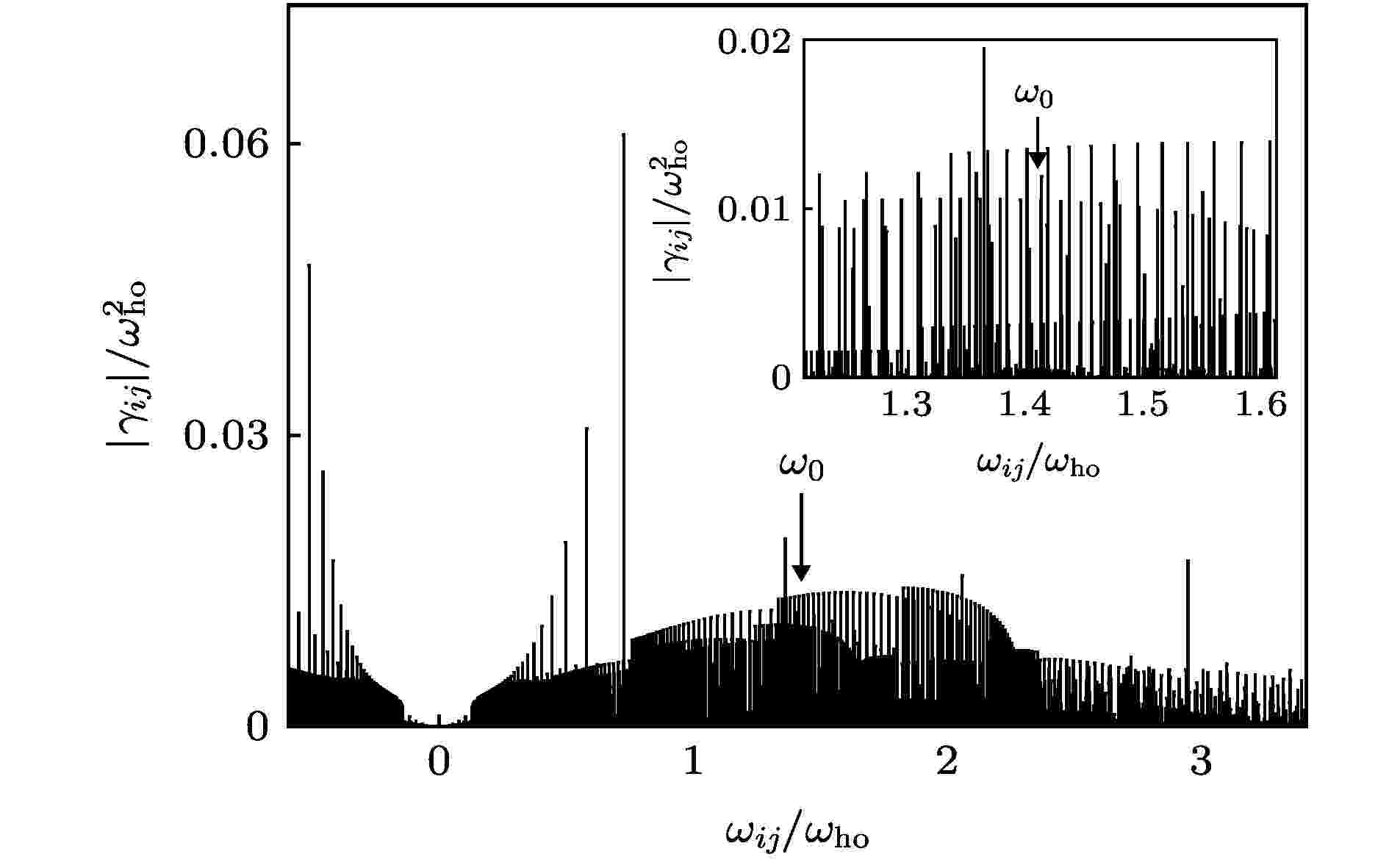
2019, 68 (23): 230304.
doi: 10.7498/aps.68.20190661
Abstract +
By using the Hartree-Fock-Bogoliubov approximation of mean-field theory and the analytic method based on Thomas-Feimi approximation, the Landau damping and frequency-shift of (0, 0, 2) scissors mode in a disc-shaped Bose-Einstein condensate are investigated and the damping rate and frequency-shift magnitude as well as their temperature dependence are calculated. In the calculation, the practical relaxations of the elementary excitations and the orthometric relation among the relaxations are considered in the relation for the perturbed eigenfrequency of mean-field theory to obtain the calculation formula of damping and frequency-shift, and the first-order approximation of Gaussian distribution function is employed for the ground-state wavefunction to eliminate the divergence of the three-mode coupling matrix elements in Thomas-Fermi approximation. Taking the same parameters of particle number, trapping frequency and anisotropy as those in relevent experiment research, our theoretical calculation results accord with the relevent experimental measurement results. Because of the complexity of the theory and the difficulty of calculation, most of mean-field theory researches on damping and frequency shift of collective excitation in one and two component Bose-Einstein condensates adopt semi-classical approximation, the quasi-particle excitation spectrum is regarded as continuously integrating each quasi-particle transition contribution to damping and frequency shift. In this paper, the damping and frequency shift are calculated according to the discrete quasi-particle excitation spectrum, and in the course of the study the improving of method of considering the practical relaxations of the elementary excitations and the orthometric relation among the relaxations is put forward. It is hoped that the method will have some reference value in the future work.
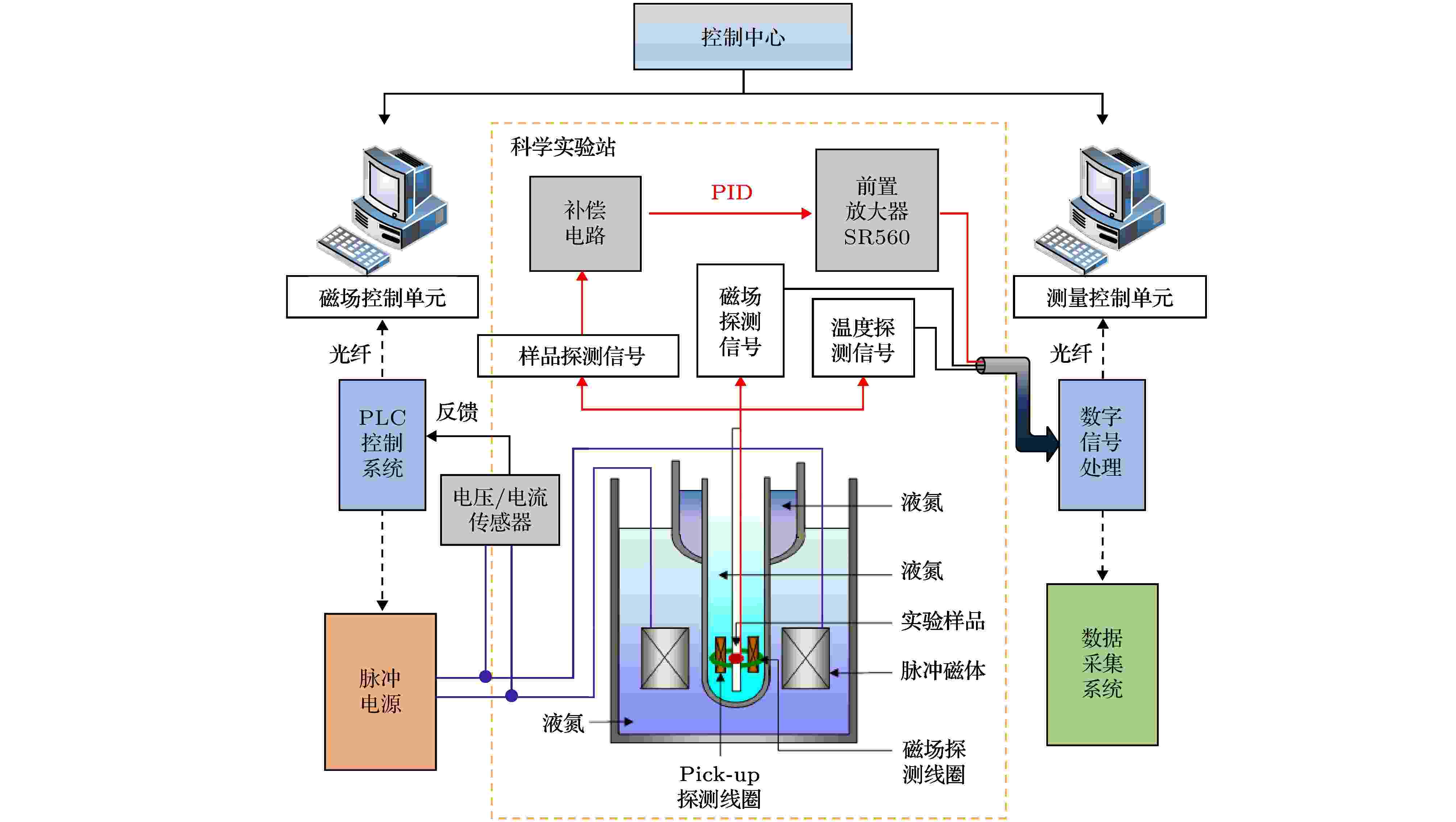
COVER ARTICLE
2019, 68 (23): 230701.
doi: 10.7498/aps.68.20191115
Abstract +
In recent years, measuring the electrical transport properties of materials in different directions of applied magnetic field has become an important experimental study of topological quantum materials. With the development of condensed matter physics, scientific research has shown that under the ultra-high intensity pulsed magnetic field, the electrical transport study of materials may extend to the quantum limit region, and more abundant physical phenomena will be observed. However, in the existing electric transport measurement system, the rotation sample rod under the action of steady-state field presents a large size and significant eddy current effect, which makes it difficult to meet the requirements for pulsed field measurement, and the current commercial physical property measurement system (PPMS) can only operate under ±16 T steady magnetic field. In addition, the conventional rotation sample rod encounters the problems of insufficient angular resolution and space utilization when used in pulsed high magnetic environment. So there is an urgent need to develop a higher performance rotation measurement system. In view of the above background, in this paper we present a kind of electrical transport measurement system designed by Wuhan National High Magnetic Field Center (WHMFC), which consists of five modules: pulse power supply, pulse magnet, control center, cryogenic system, and signal measurement. The key component is the sample measuring rod with rotation function, which restricts the movement of the drawbar through a double-groove structure to achieve an angular change in a range from –5° to 185°. An angle calibration coil is mounted on the back of the sample stage. Based on the double-calibration method, the angle control accuracy of 0.1° is achieved. The temperature, magnetoresistance and Hall resistance signal are collected by the integrated circuit on sample stage and extracted by compensation circuit and virtual digital lock-in amplifier, and the accuracy of electric transport measurement is better than 0.1 mΩ. Furthermore, the effect of eddycurrent and material deformation at low temperatures are completely eliminated by using polyetheretherketone material, which effectively improves the stability and reliability of the rotation sample rod. Using this measuring rod, we complete a series of experiments in the 8 mm sample cavity in the center of the pulse magnet: the minimum ambient temperature reaches 1.3 K, the maximum magnetic field strength arrives at 65 T, and the direction angle of the magnetic field is able to change in a 190° range. Thus the universally applicable measurement system of electric transport experiment in pulsed high magnetic field is successfully established. In this paper, we elaborate the principle and device components of the measurement system, the design and fabrication of the angle measuring rod, and the calibration principle and measurement process. Relevant experimental results show that the system has important application value in the research of 3D Fermi surface, topological insulator surface state, quantum limit transport, superconductivity analysis, etc. Based on this system, the electrical transport experimental system at WHMFC provides an effective means for the relevant research teams (home and abroad) engaged in the exploration of the intrinsic physical characteristics of quantum materials in extremely pulsed high magnetic field and low temperature environment.
INVITED REVIEW
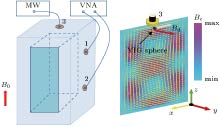
EDITOR'S SUGGESTION
2019, 68 (23): 230305.
doi: 10.7498/aps.68.20191608
Abstract +
Recently, the hybrid cavity-magnon system has attracted considerable interest. Owing to the good tunability of magnons, it is promising to use the magnons as a core to implement a hybrid quantum platform for transferring information among different quantum systems. In this article, we first briefly review the cavity magnonic systems and clarify the coupling mechanism between magnons and microwave photons. Then, we introduce the latest research progress in the aspects of nonlinearity and pseudo-Hermiticity, including the bistability of cavity magnon polaritons, observation of the second-order exceptional point in a PT-symmetric hybrid cavity-magnon system, and the pseudo-Hermiticity with a third-order exceptional point.
NUCLEAR PHYSICS
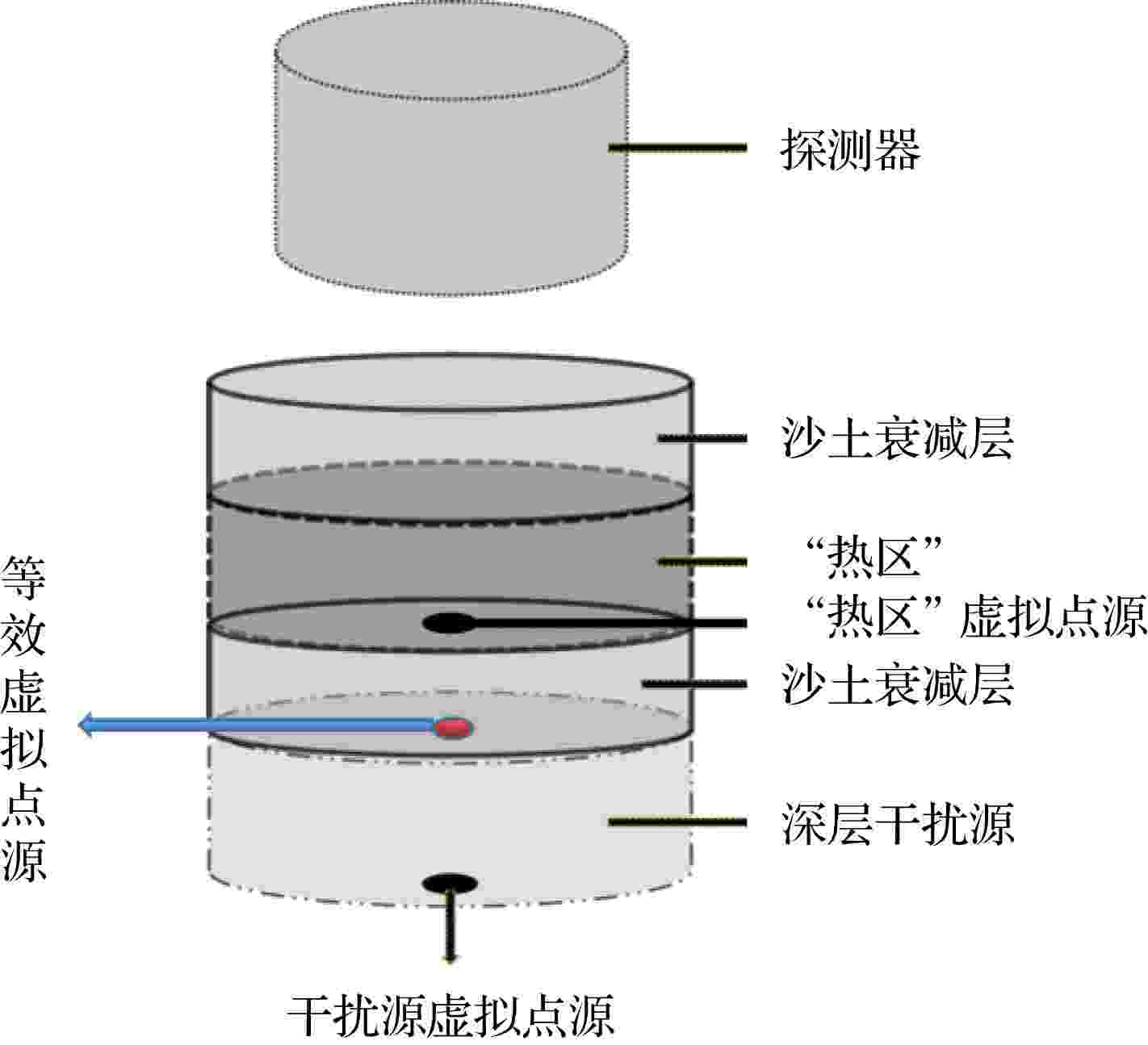
2019, 68 (23): 232901.
doi: 10.7498/aps.68.20191095
Abstract +
In the in situ γ spectrometer based measurement of " hot particular”, " radioactive collection point” and " radioactive collection area”, only the position of the pollution source can be located roughly, but its boundary parameters such as the thickness of pollution source cannot be given. In this paper, the application of virtual technology to the scanning of γ spectrometer is studied. We convert γ spectrometer measurement objects into a four-layer theoretical model, which are attenuation thickness + radioactive hot area + attenuation thickness + disturb source. Then, the source item layer is virtualized into a point source by using virtual technology. So, the theoretical model is further simplified. Then the detection efficiency and peak/valley ratio parameter of source term are simulated by Monte Carlo method. Finally, the source term parameters are retrieved by using the least square method, and thus establishing the theoretical method and procedure of inversion calculation of source boundary parameters. In this paper, the theoretical and experimental results are shown to be consistent with each other. So, this method is verified to be correct and practicable. Currently, the method can accurately determine the depth distribution parameters of radioactive contamination area for uniformly distributed radio nuclides. In conclusion, the technical achievements can be used to accurately determine the boundary range of the radioactive hot zone, thus realizing the purpose of reducing the waste disposal capacity during the treatment. At the same time, the determination of the inert layer thickness parameters of the target nuclear warhead of Nuclear Test Ban Treaty has a significant reference value.
ATOMIC AND MOLECULAR PHYSICS

EDITOR'S SUGGESTION
2019, 68 (23): 233301.
doi: 10.7498/aps.68.20190515
Abstract +
Temperature is one of the important parameters to measure the combustion efficiency. The measurement of temperature is of great significance for saving energy and reducing emission in industrial combustion process and diagnosing the engine state. The tunable diode laser absorption spectroscopy is a non-invasive measurement technology with strong environmental adaptability for fast, in-situ detection. Based on the three absorption lines of H2O at 7185.6 cm–1, 6807.8 cm–1 and 7444.35/37 cm–1, the wavelength modulated spectrum absorption model is established and laboratory-calibrated; using the background-subtracting WMS-2f/1f method and the best fit method, the temperature is measured. The outlet temperature of the single-head combustion chamber is accurately realized. The outlet temperature of the single-sector combustion chamber is also accurately measured. The measurement is verified in a pressure range of 3.39-10.58 atm and a temperature range of 958-1512 K. The time resolution of the measurement system is less than 1 ms, and the measurement error is less than 5.68%, thus verifying the practicality of the measurement method and the stability of the measurement system.
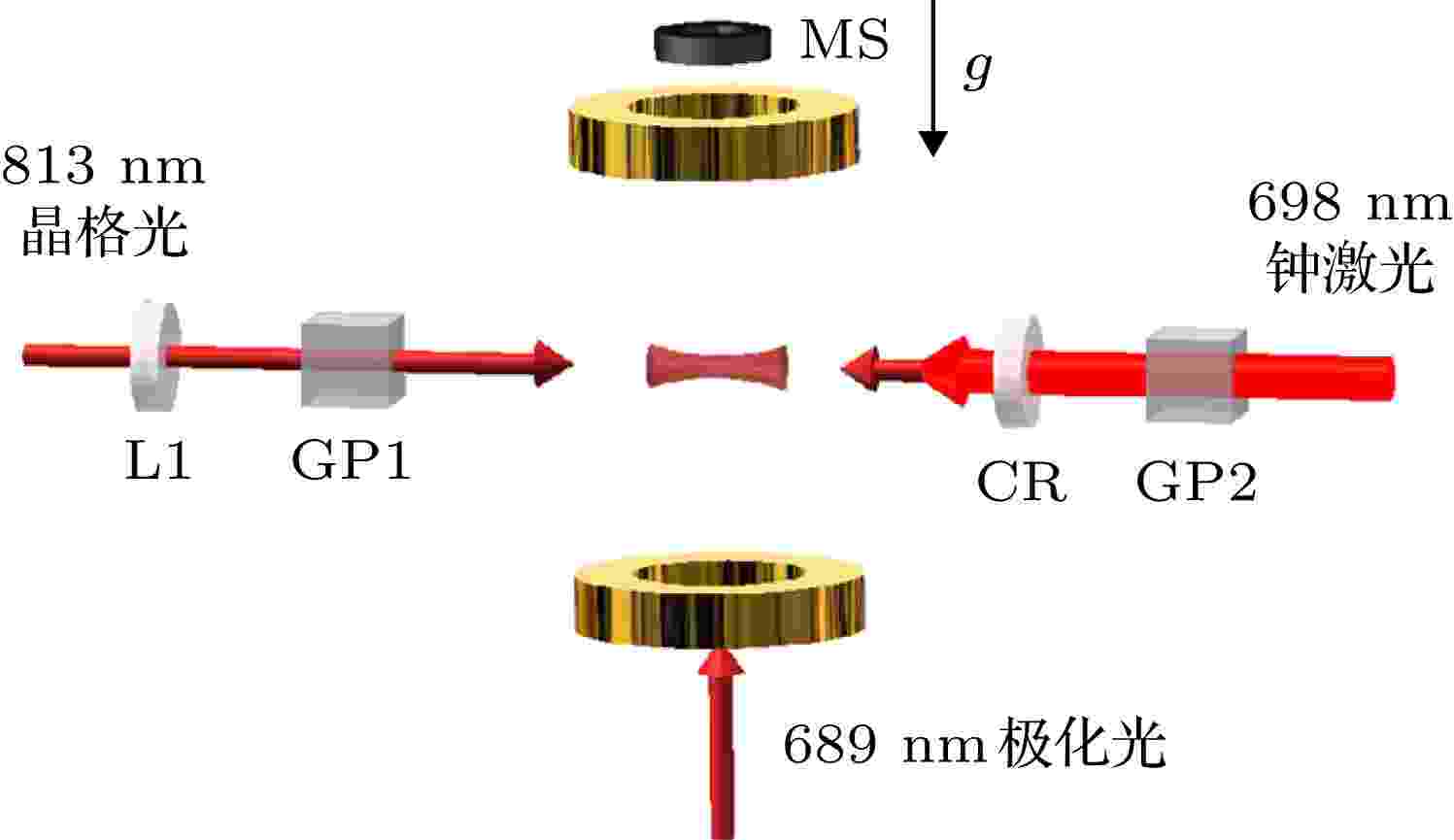
2019, 68 (23): 233401.
doi: 10.7498/aps.68.20191147
Abstract +
In a one-dimensional Fermion optical lattice clock, the p-wave scattering can occur when collision energy is sufficient to overcome the centrifugal barrier of p-wave scattering. According to Pauli exclusion principle, the s-wave scattering is forbidden between two identical Fermions. However, the s-wave scattering may also exist due to inhomogeneous excitation which leads to some difference between two Fermions. In terms of the uncertainty evaluation of a neutral atomic optical lattice clock, the frequency correction and uncertainty caused by atomic interaction cannot be ignored, and it will affect the evaluation of AC stark frequency shift. So the uncertainty evaluation of the collision frequency shift should be as small as possible. Only in this way can a neutral atomic optical lattice clock have a state-of-the-art performance. The collision frequency shift originates from the interaction between atoms trapped in an identical lattice. In this study, the collision frequency shift of 87Sr optical lattice clock at the National Timing Service Center is measured experimentally. A horizontal one-dimensional optical lattice is constructed. The number of tapped atoms is about 104 at a temperature of 3.4 μK. A laser is used to pump the atoms to either of the Zeeman energy levels of mF = ± 9/2 in the ground state, and the clock transition spin polarization spectrum is obtained. In a spin polarized Fermions system, the collision frequency shift relating to atomic density is measured by the method of self-comparison. The method of self-comparison, which takes full advantage of the excellent short-term stability of the clock laser, can be used to measure the frequency difference caused by the variety of system parameters. Owing to the fact that the collision frequency shift is proportional to atomic density, the collision frequency shift can be measured by the method of self-comparison between high and low atomic density. In the experiment, the systematic state is changed between high and low atomic density by periodically changing the loading time of the first stage of cooling. In order to reduce the statistical uncertainty of the measurement, the collision frequency shift is separately measured 37 times. Finally, when the atomic density is 4 × 1010/cm3, the collision frequency shift is –0.13 Hz, and the statistical uncertainty of the measurement is 3.1 × 10–17. The Allan deviation of self-comparison between low and high atomic density reaches 4 × 10–17 after 8000 s averaging time, indicating that the accuracy of the measurement is reliable and on the order of 10–17. This work lays a foundation of the total uncertainty evaluation of 87Sr optical lattice clock.
ELECTROMAGNETISM, OPTICS, ACOUSTICS, HEAT TRANSFER, CLASSICAL MECHANICS, AND FLUID DYNAMICS
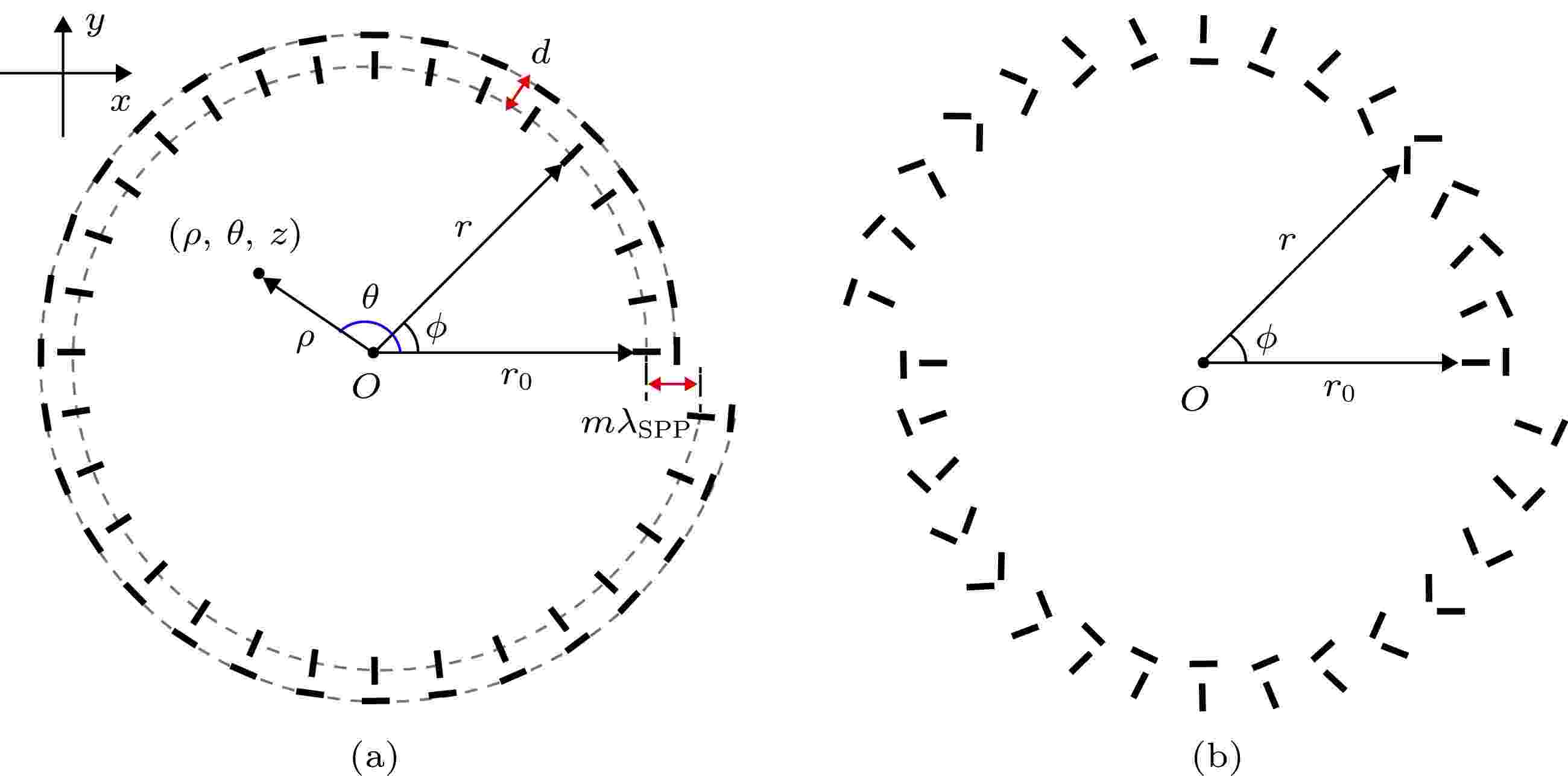
2019, 68 (23): 234201.
doi: 10.7498/aps.68.20190747
Abstract +
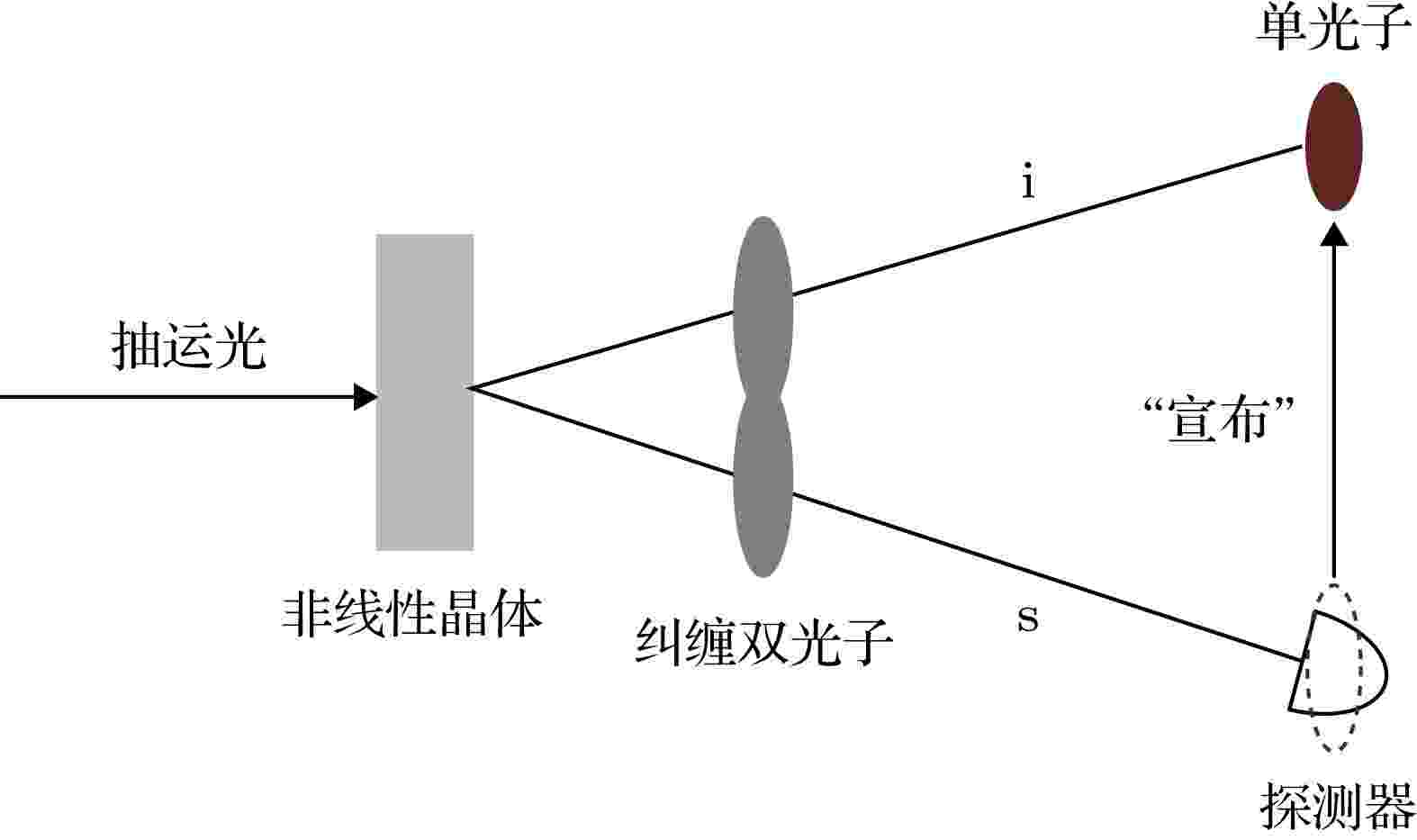
2019, 68 (23): 234202.
doi: 10.7498/aps.68.20190532
Abstract +
The method by measuring one photon of an entangled two-photon pair to simultaneously herald another photon as the single photon, is one of the important ways to prepare the desired single-photon source. However, achieving high herald efficiency is still an open problem. In this paper, with the polarization entangled photon pairs generated by the parametric down-conversion process in the I-type phase-matched BBO ($|+/-\rangle$ heralded basis is enhanced 4% compared with that with the $|H/V\rangle$ heralded basis.

2019, 68 (23): 234203.
doi: 10.7498/aps.68.20191168
Abstract +
Entangled state of light with quantum correlations between amplitude and phase quadratures is a necessary quantum resource in optical continuous variable (CV) quantum information systems. The CV Einstein-Podolsky-Rosen (EPR) entangled optical field is one of the most basic quantum resources, which can be generated by a non-degenerate optical parametric amplifier (NOPA) operated below the threshold pump power. Manipulating the EPR entangled state of light effectively can break through the limitation of the imperfect performance of optical components in optical cavities and then further improve the entanglement level under certain conditions. So it is necessary to find out an effective optical scheme of manipulating quantum state of light. The non-measurement based coherent feedback control (CFC) system without introducing any extra noise into the controlled system, can be used to stabilize, control and improve the performance of various quantum systems. Only by selecting the right experimental parameters can the CFC system play its positive role in reaching a maximum efficacy. The key optical component, i.e. optical controller in CFC system, greatly affects the final manipulation effects. In 2015, using the method of CFC, our research team experimentally realized the enhancement of entanglement to different levels by changing the optical controller with different transmissivity values for seed optical beams. At the same time, the threshold pump power of the NOPA is reduced to different levels also. Due to the technical reasons, the transmissivity of the optical controller selected in the experiment is almost the same for the signal optical field and idle optical field. In this paper, we emphasize the condition that the transmissivity of the optical controller for the signal optical field is different from that for idle optical field. Firstly, we theoretically study the final effects of manipulating entanglement source by using the coherent feedback optical cavity under the above conditions. It is concluded that if the transmittance of control beam splitter (CBS) is low, the feedback control optical cavity works best when the optical controller has different transmissivity for signal optical beam and idle optical beam, and that if the transmittance of CBS is high, the transmittance of the optical controller for signal optical beam almost equals that for idle optical beam to make the feedback control optical cavity work best. Then we theoretically investigate the dependence of the quantum correlation noise of the quadrature amplitude and quadrature phase of the output optical fields from CFC-NOPA system on other physical parameters. Combining with the actual experimental conditions, we can find the optimal transmissivity of the optical controller and appropriate range of frequency to optimize the effects of CFC, which provides the basis for correctly selecting the actual experimental parameters in CFC systems. Theoretical analysis results also show that with the higher input and output coupling efficiency and higher nonlinear conversion efficiency of NOPA, the entangled state of light with higher entanglement degree can be obtained experimentally. This provides the reference for obtaining better quantum resources needed for studying the CV quantum information.
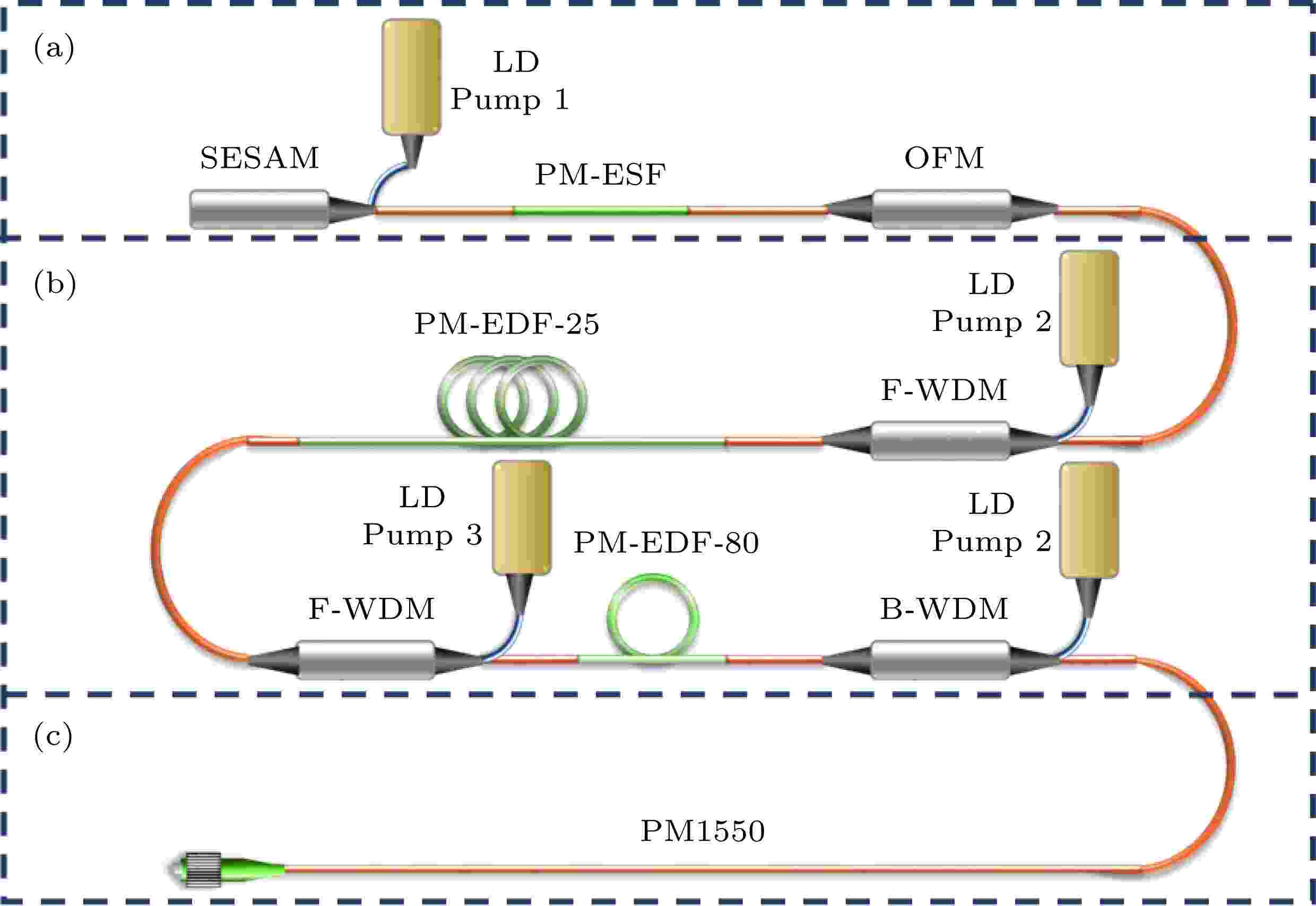
2019, 68 (23): 234204.
doi: 10.7498/aps.68.20190925
Abstract +
The erbium-doped fiber oscillators, especially mode-locked fiber oscillators for generating femtosecond pulses, cannot meet the requirements for most of modern industrial applications because they are resticted by the low power and the limited wavelength range. In order to solve this problem, lots of efforts have been made both theoretically and experimentally, to improve the chirped pulse amplification (CPA) technology. The emergence of CPA technology greatly enhances the energy of laser pulses. The broadening and compressing of the laser pulses are both always dependent on the improving of spatial optical components, such as grating pairs. However, the use of this kind of method can increase the complexity of the amplification system to a certain extent. This may be an essential reason why more and more researchers pay attention to all fiber amplification system. In this paper, the master oscillator pulse nonlinear amplifier system based on all polarization- maintaining fiber is proposed, which is mainly composed of an oscillator based on the semiconductor saturable absorption mirror and linear cavity, a two-stage amplification and a pulse compressor constructed by a single-mode conductive fiber with anomalous dispersion. Using this system, we obtain ultrashort laser pulses in the 1.5 nm band whose pulse width equals 44 fs and single pulse energy reaches about 1 nJ. The system is not only compact and miniaturized but also stable and reliable due to the all polarization-maintaining fiber. Subsequently, an MgO doped periodically poled lithium niobite crystal with a thickness of 1 mm is used to implement frequency doubling. The pulses from the system are accurately focused on a position where the crystal polarization period is 19.8 μm with help of some wave plates and lenses. Adjusting the optical path reasonably and optimizing colliminated focusing parameters, the double-frequency pulse output with certral wavelength of 779 nm and average power of 60 W is obtained, in which the conversion efficiency reaches 30%. The result shows that the master oscillator pulse nonlinear amplifier system based on all polarization maintaining fiber can produce satisfactory ultrashort pulses. It is a new idea for generating the ultrashort femtosecond pulses in the near-infrared band.
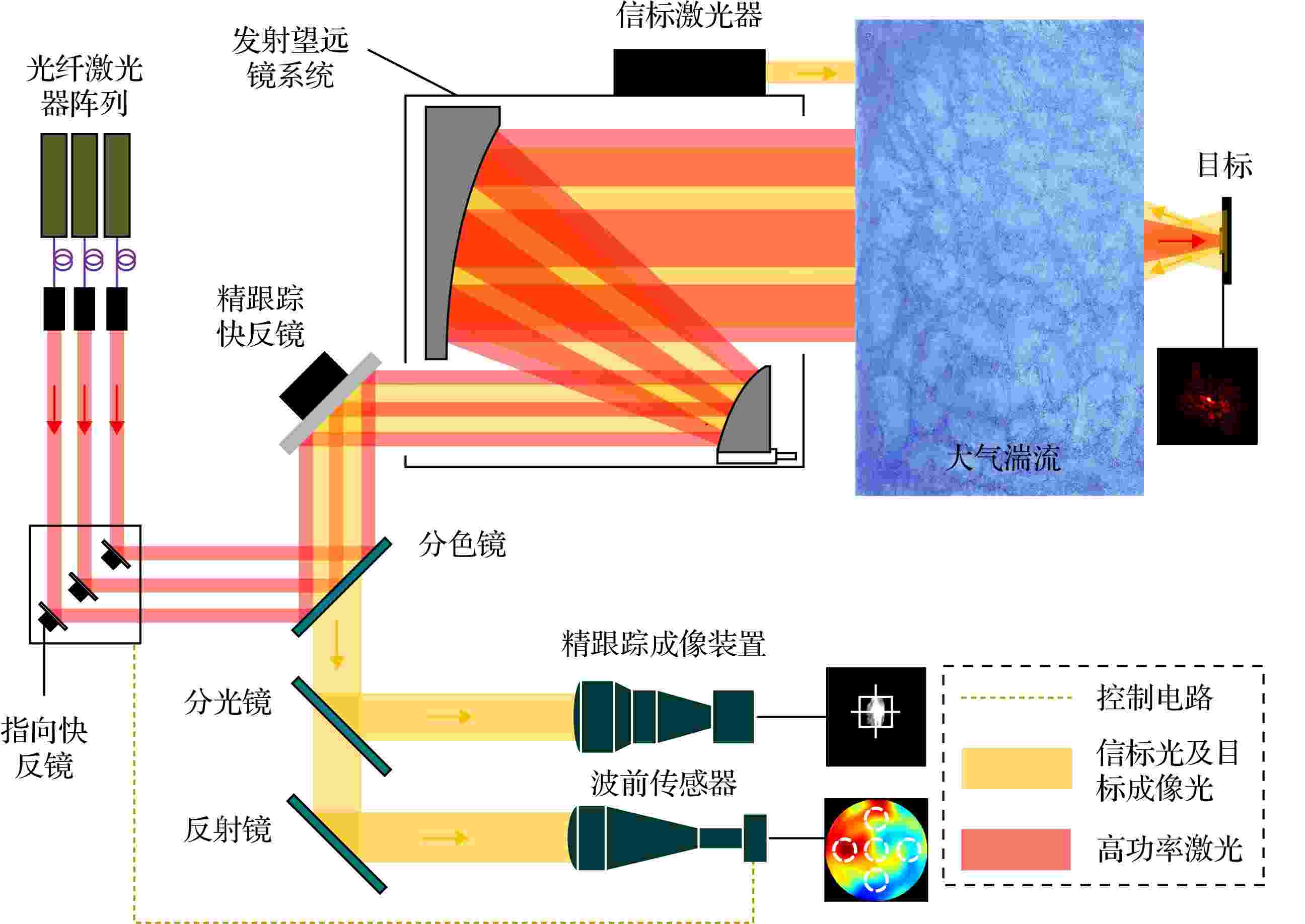
2019, 68 (23): 234205.
doi: 10.7498/aps.68.20190961
Abstract +
The beam quality of array lasers which propagate in atmosphere will degrade in far-field. Therefore, the ultimate efficiency of combined lasers will be affected if no compensation measure is taken in some typical systems such as high energy system. Based on the model of array lasers with incoherent combination, laser propagation in atmosphere is simulated by generating a random atmospheric turbulence phase screen to modulate the phase of the laser beam. The distorted wavefront of atmospheric turbulence is divided according to the array distribution. The phase generated by tilt aberration coefficient which is solved by the method of fitting sub-wavefront data is eliminated in the phase of sub-beam, which simulates the process of correcting tilt aberration. The simulation results show that comparing with the case of tilt aberration, the power in the bucket (PIB) and the Strehl rate (SR) of combined lasers focusing in far-field are improved when the tilt aberration influenced by the same atmospheric turbulence phase screen is corrected. At the same time, coherence length ranging from 4 cm to 45 cm is used to characterize atmospheric turbulence of different intensities. At each coherent length, the PIB and SR are calculated when the distances of propagation of lasers are 2 km and 3 km, separately. The simulation results show that although PIB and SR before and after tilt aberration are corrected, they become worse with the decrease of coherence length, and PIB and SR are improved more obviously when tilt aberration is corrected in stronger turbulence. An experiment in the case of 2 km is carried out by using a prototype of incoherent combination, and the data are obtained by measuring the focused spot at the target. The measurement results confirm that the correcting of tilt aberration can improve the beam quality of array lasers with incoherent combination in far-field. In summary, the research conducted in this work can obtain tilt aberration accurately and the corresponding method of correction is easy to implement, which can provide supporting data for improving the performances high energy laser systems.
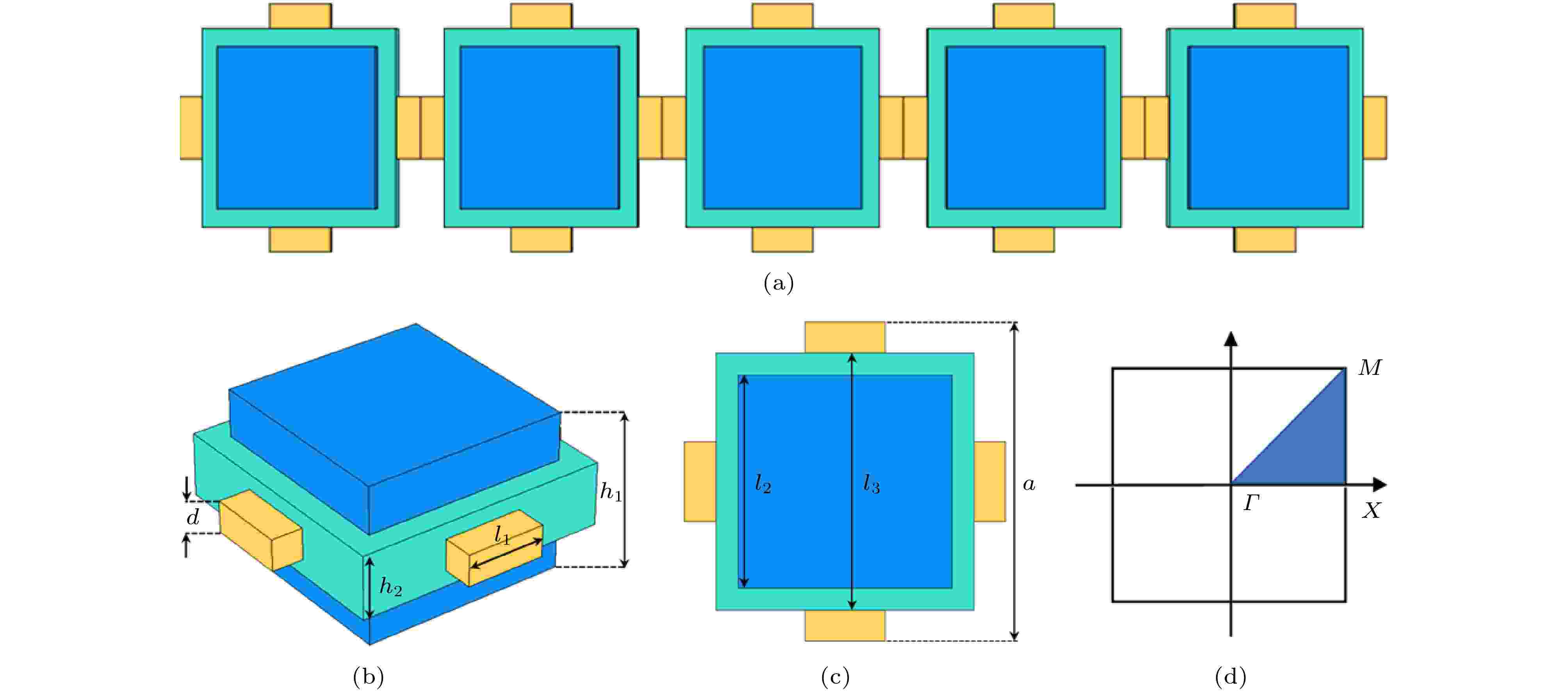
2019, 68 (23): 234206.
doi: 10.7498/aps.68.20190260
Abstract +
The band structure and transmission characteristics of a new two-dimensional (2D) piezoelectric phononic crystal plate consisting of four epoxy short plates periodically connected with a square lattice of a prismatic piezoelectric material coated with plexiglass are investigated by supercell method and finite element method. By changing the electric boundary conditions imposed on the upper and lower surfaces of piezoelectric scatterers, a point defect waveguide with adjustable paths is formed, which overcomes the limitation of immutability in the direction of the vibration waveguide, with material and structural parameters fixed. Then the controlling of the piezoelectric effect can change the material parameters of piezoelectric components in phononic crystals, showing that the piezoelectric constants have a great influence on the complete bandgap, which is beneficial to the formation of defect states; when the frequency of the defect state appears in the band gap, the frequency-responding range of the defect state expands. The analysis of the displacement vector field indicates that the strain energy in the resonance of the new structure is almost completely limited to the upper and lower surfaces of the central piezoelectric scatterer. We use the recycling circuit to connect the electrodes on the upper and lower surfaces of the piezoelectric sheet. At this time, the output electrical energy can supply the power to the DC load, and the mechanical energy of vibration can be converted into electrical energy. The results of this work provide a reference for the self-powered technology of waveguide and wireless sensor device with adjustable path.

2019, 68 (23): 234301.
doi: 10.7498/aps.68.20191334
Abstract +
One of the challenges relating to acoustic metamaterials is to achieve a tunable performance without modifying the structure. In this paper, we propose two types of acoustic metamaterials with a magnetorheological elastomer (MRE), and their tunable band gap structures and the transmission spectra are investigated by the finite element method (FEM). The MRE acts as a cladding layer, and its shear modulus can be changed by an externally applied magnetic field. The cell resonance frequency of acoustic metamaterial is changed. The band gap structures and the transmission spectra of the two kinds of acoustic metamaterials are calculated under various magnetic fields, and it is found that the frequency and width of band gap, the maximum attenuation frequency and transmission loss of transmission spectrum increase with externally applied magnetic field intensity increasing. Meanwhile, two types of the mass-spring models are used to estimate the band gap frequencies of the two kinds of acoustic metamaterials. The FEM results are in good agreement with the estimation results. In addition, the effects of material parameters of core and shell and filling rate on the band gap and transmission spectrum are also studied. The effects of core material parameters on the band gap and transmission spectrum of single-layer acoustic metamaterial are analyzed. It is found that the core mass has an effect on the band gap frequency and width, and the elastic parameter of the core affects the transmission loss of the transmission spectrum. The influences of core and shell material parameter on the band gap and transmission spectrum of double-layer acoustic metamaterial is analyzed by the control variable method. The results show that the core and shell mass affect the band gap frequency, width and pass-band width, and the elastic parameter of the core and the shell affect the transmission loss of the transmission spectrum. As the filling rate increases, the band gap frequency and width of the single- and double-layer MRE acoustic metamaterial increase, the maximum attenuation frequency of the transmission spectrum does not change, and the transmission loss increases. These results will greatly contribute to the application of acoustic metamaterials to controlling the active noise and vibration.

2019, 68 (23): 234302.
doi: 10.7498/aps.68.20191198
Abstract +
In previous papers, researchers generally adopted a simplified assumption that there is a single type of bubble in liquid. In this paper, two simplified bubbles models are established based on the shape and structure of cavitation bubbles formed in ultrasonic field, i.e. linear model consisting of three bubbles and cluster model composed of five bubbles, and each model is assumed to consist of two types of bubbles. The influences of large bubbles on cavitation effect of small bubble in the middle for three- and five-bubble model are numerically studied by using the modified Keller-Miksis equation and van der Waals equation. The changes of the expansion radius of the small bubble in the middle, the temperature in the small bubble and the secondary Bjerknes force between large bubble and small bubble with the increase of the initial radius of large bubbles are mainly investigated. In the calculation, it is assumed that the locations of bubbles stay unchanged and the shape of bubbles remains spherical in the oscillation process. Meanwhile, the time-delay effect on the secondary Bjerknes force can be neglected because the sound wave speed is very fast in water and the bubbles in the liquid can oscillate synchronously. The calculation results show that the expansion of small bubble in the middle can be completely suppressed or delayed when the initial radius and the number of bubbles are appropriate on condition that the distance between large and small bubble, the driving sound pressure and frequency of the applied sound field stay unchanged. The main reason for delayed expansion is that the total pressure acting on small bubbles is delayed to form a negative pressure in the process of the change. The collapse time of delayed expansion of small bubble is basically the same as that of large bubbles, which makes small bubble collapsed rapidly and thoroughly under the strong radiative barotropic effect of large bubble's collapse, and leads the maximum temperature in the small bubble to be higher than that of the single bubble with the same initial radius and the small bubble with normal expansion. In addition, when the expansion of small bubble is delayed, the secondary Bjerknes force between the large bubble and the small bubble appears to be repulsive first and attractive then. This rule is different from the change rule of the secondary Bjerknes force between the two bubbles in normal expansion. The results in this paper have significant theoretical guidance for specific problems such as suppressing liquid cavitation or enhancing liquid cavitation effect by the manual injection of large bubbles.

2019, 68 (23): 234303.
doi: 10.7498/aps.68.20190663
Abstract +
In engineering, the combustion chamber with a backward step is very popular, and it is a kind of flame stabilizer. In this type of combustion chamber, there will be shedding vortices at the step due to the instability of the flow field. The shedding vortices will carry reactants to move downstream and burn, resulting in unstable heat release and then pressure and velocity fluctuations of the sound field, thereby, finally, forming a combustion-vortex-acoustic interaction process. If a positive feedback loop is formed between the unstable heat release and the pressure fluctuation of sound field, combustion instability will occur, and it is also referred to as thermoacoustic oscillation due to vortex shedding. Combustion instability frequently occurs in many practical systems or equipment, and its induced significant pressure oscillations have a serious influence on the normal operation of the equipment. Recently, the combustion instability has been extensively studied experimentally, but the theoretical investigation on its nature is still rare. Since combustion instability is a complicated nonlinear phenomenon, it is necessary to study its nature from the viewpoint of nonlinear dynamics. Based on the one-dimensional simplified model of thermoacoustic instability involving vortex shedding proposed by Matveev and Culick, the typical nonlinear phenomenon in thermoacoustic oscillation induced by vortex shedding is studied. The study focuses on the initial value sensitivity of the system, the influence of key parameters on thermoacoustic oscillation, and the phenomenon of vortex-acoustic lock-on. Firstly, the Galerkin method is used to approximate the governing equation, and the partial differential equations are reduced to a set of ordinary differential equations. Then, the first ten modes are selected, and the pressure and velocity fluctuations of sound field under different system parameters are obtained by MATLAB program. Finally, the thermoacoustic instability of the system under different initial disturbances, the influences of different steady flow velocity on the thermoacoustic oscillation of the system, and the phenomenon of vortex-acoustic lock-on in thermoacoustic oscillation are studied in detail. The results show that the system of thermoacoustic oscillation involving vortex shedding is extremely sensitive to initial values, and there are a rich variety of nonlinear phenomena. With steady flow velocity increasing, the amplitude of pressure fluctuation augments generally. However, the similar structures are found in several intervals of steady flow velocity, and the amplitude first decreases and then increases. In particular, it is verified that the system oscillates periodically by integer (fp/fs) multiple of the vortex impinging frequency (fs), that is, the vortex-acoustic frequency locking with the number of revolutions fp/fs, which is found in experiment and can be regarded as an important characteristic of periodic thermoacoustic oscillation.

2019, 68 (23): 234501.
doi: 10.7498/aps.68.20191071
Abstract +
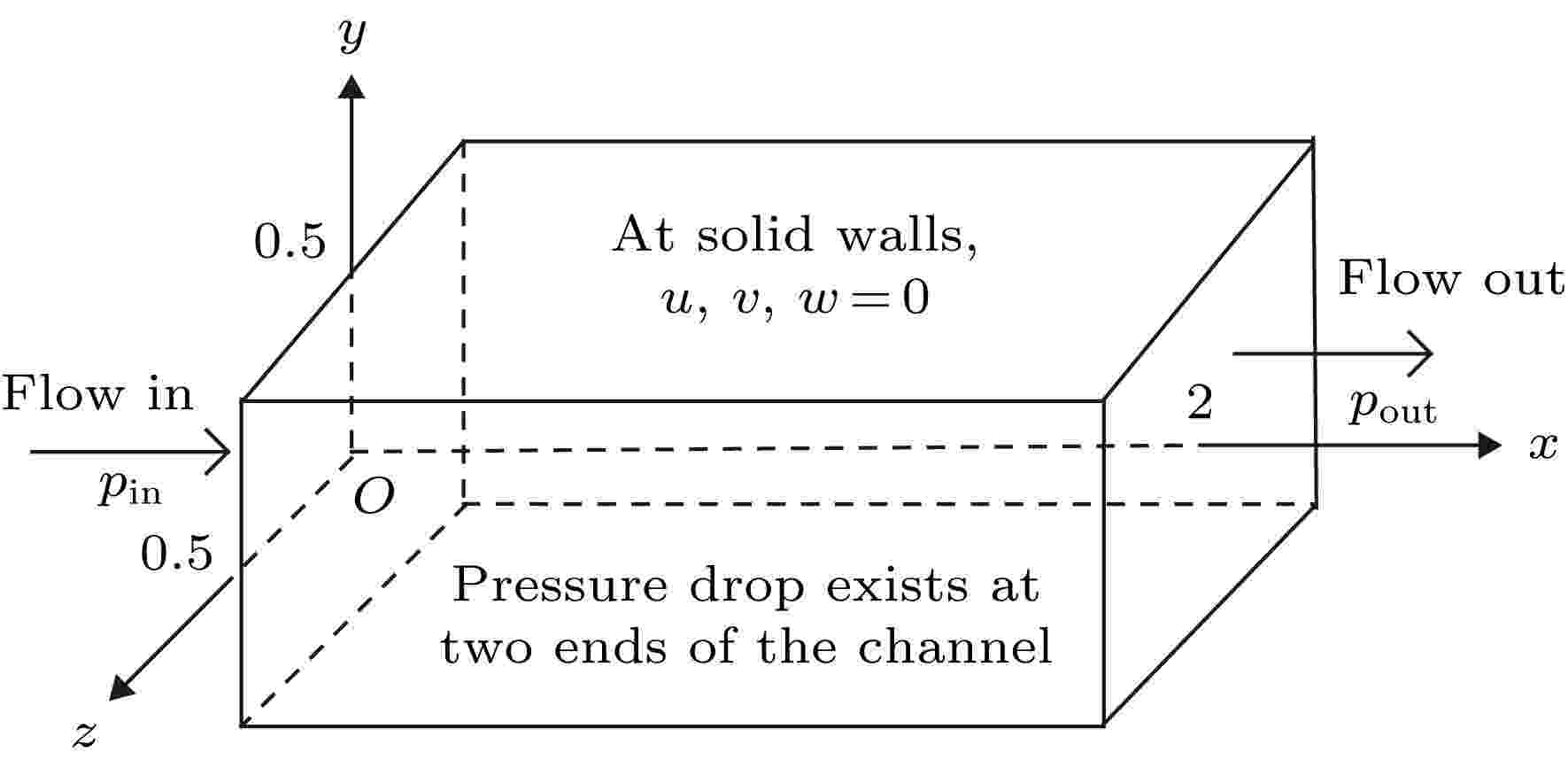
2019, 68 (23): 234701.
doi: 10.7498/aps.68.20190984
Abstract +
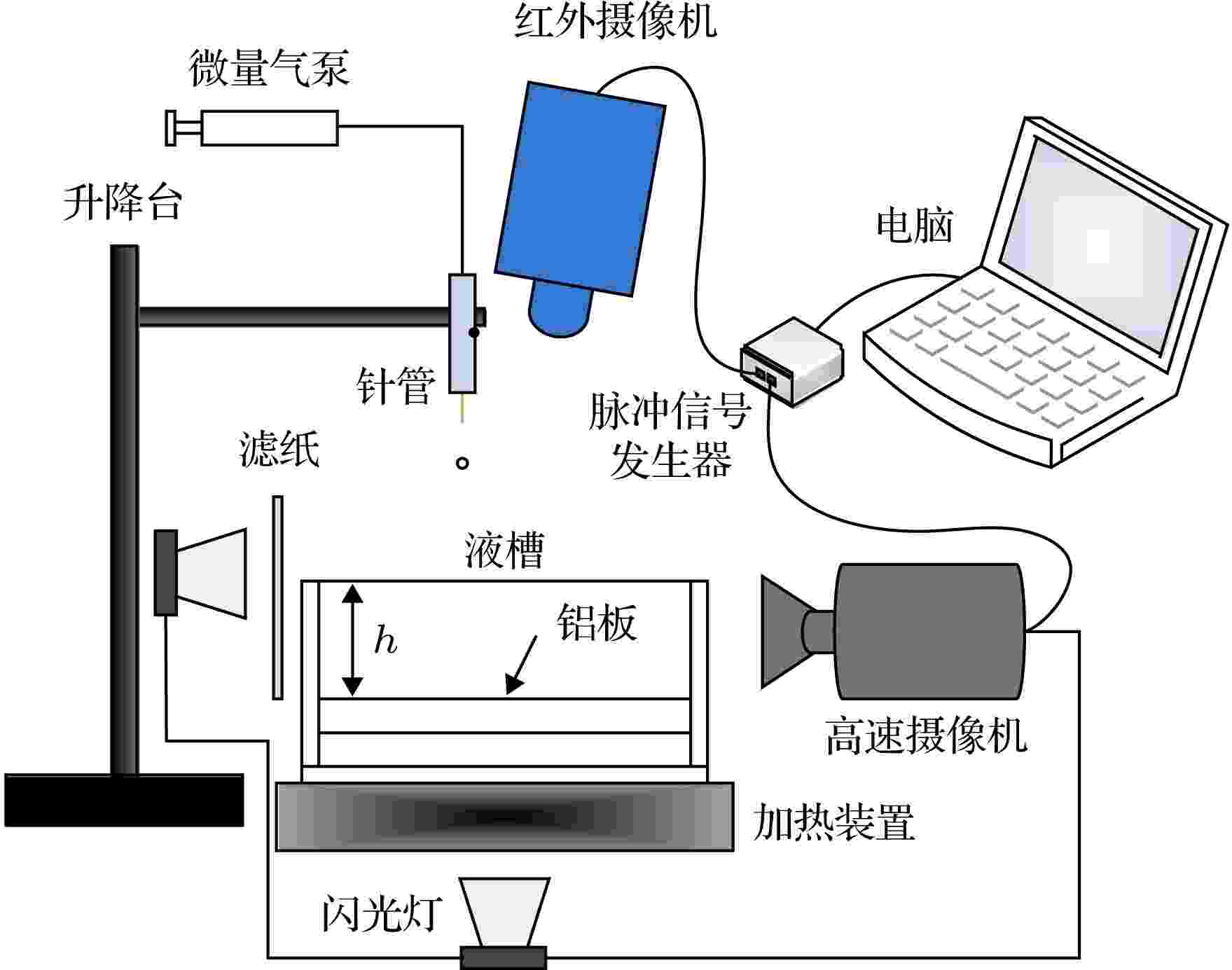
2019, 68 (23): 234702.
doi: 10.7498/aps.68.20190809
Abstract +
A high speed camera-infrared camera synchronous shoot device is built to record the process of cold droplet impacting on hot pool and lots of experiments have been done in this paper. The mixing morphology and the temperature variation of the impact area are observed and analyzed based on simultaneous images taken by the infrared camera and the high speed camera. The influences of the impact conditions on mixing and heat transfer during droplet impacting on hot pool are also studied and then the dimensionless relationship between mean temperature of the impact area and impact condition is established. The experimental results show that the mixing of cold liquid from droplet and hot pool is one of the main reasons for the temperature increase in impact area. The cold droplet does not integrate with hot pool immediately at the beginning of impact and the droplet is deformed into a shape of " crescent moon” which is trapped near the crater. The interface between cold liquid from droplet and hot pool can be observed in a simultaneous image. When the crater begins to collapse, the mixing liquid is mainly divided into two parts: one part is left and curled at the bottom of the pool while the other part is rising with the central jet. Despite the stagnation at the beginning, the mean temperature increases with time going by in the early stage. However the growth trend is interrupted by the cavity collapse. The mean temperature arrives at a peak after the crater has reached its maximum depth. The peak of the dimensionless temperature $T_{{\rm{peak}}}^{\rm{*}}$ increases with the Weber number increasing and $T_{{\rm{peak}}}^{\rm{*}}$ can be described as $T_{{\rm{peak}}}^{\rm{*}} = 0.34W{e^{0.15}}$ . The dimensionless time of the peak ${\tau _{{\rm{peak}}}}$ increases with the Froude number increasing. In this paper, we also find that the dimensionless time of the peak ${\tau _{{\rm{peak}}}}$ can be described as ${\tau _{{\rm{peak}}}} = 0.85F{r^{5/8}}$ . After the mean temperature reaches the peak, the growth trend presents a trend of fluctuations. The shape of the trend line during this stage is related to Weber number. When the Weber number is small, the growth trend of mean temperature decreases in a short period of time and then restores and increases with time going by. When the Weber number is bigger, the growth rate becomes smoother during the long fluctuation period. The mean temperature will increase very slowly at the end of the impact. Only some cold spot are left on the surface during this period and the rising of the mean temperature becomes steady and slow.
PHYSICS OF GASES, PLASMAS, AND ELECTRIC DISCHARGES

2019, 68 (23): 235201.
doi: 10.7498/aps.68.20191026
Abstract +
The matter can be instantaneously heated up to a high energy density state by the high power laser. When the high power laser is injected into silver spherical hohlraum, the high temperature radiation source formed in the hohlraum can drive the high velocity blast wave in the laboratory to study various astrophysical phenomena such as supernova remnants, stellar jets, etc. As the basis of laser driven blast wave experiments, the first experimental results of energy coupling and partitioning of silver spherical hohlraum with one laser entrance hole (LEH) on Shenguang Ⅲ prototype laser facility are introduced in this work. Four beams with 3.2 kJ of laser energy in a 1ns square laser pulse from the upper hemisphere are used to heat the silver spherical hohlraum targets. The silver spherical hohlraum targets are 800 μm-diameter and 650 μm-diameter LEH, and are fabricated by electroforming silver onto an acrylic mandrel. The laser coupling and partitioning to the targets are investigated by using the optical and X-ray diagnostics. The experimental results show that the radiation temperature is beyond 240 eV, the laser-to-X-ray conversion efficiency of silver hohlraum is 0.68 and the silver albedo is 0.83. With the driving of the high temperature radiation source, most of laser energy is coupled to the residual shell, and the high velocity blast wave can be generated. The laser energy not coupled to the target is lost through scattering light, emitting hot electrons and radiating X-rays. The experimental results show that the fraction of energy lost due to the scattering light is 15%, that due to emitting the total hot electrons is less than 1%, almost 30% of the laser energy is lost from the LEH by radiating the X-ray flux, almost 9% of the laser energy leaks from the spherical shell consisting of the 5.6 μm-thick Ag layer and 10 μm-thick CH layer through the X-ray radiation flux, and 45% of the laser energy is converted into the kinetic energy and internal energy of the remaining spherical shell. Therefore, more than 50% of the laser energy will be used to drive the high velocity blast wave in the subsequent experiments. After 950 ps, the silver plasma is concentrated in the center of the silver spherical hohlraum, which does not affect the injection of 1ns laser. The experiment on energy coupling and partitioning of a spherical silver hohlraum laser is carried out for the first time on Shenguang Ⅲ prototype laser facility, which lays a foundation for the subsequent experiments on laser driven blast wave.
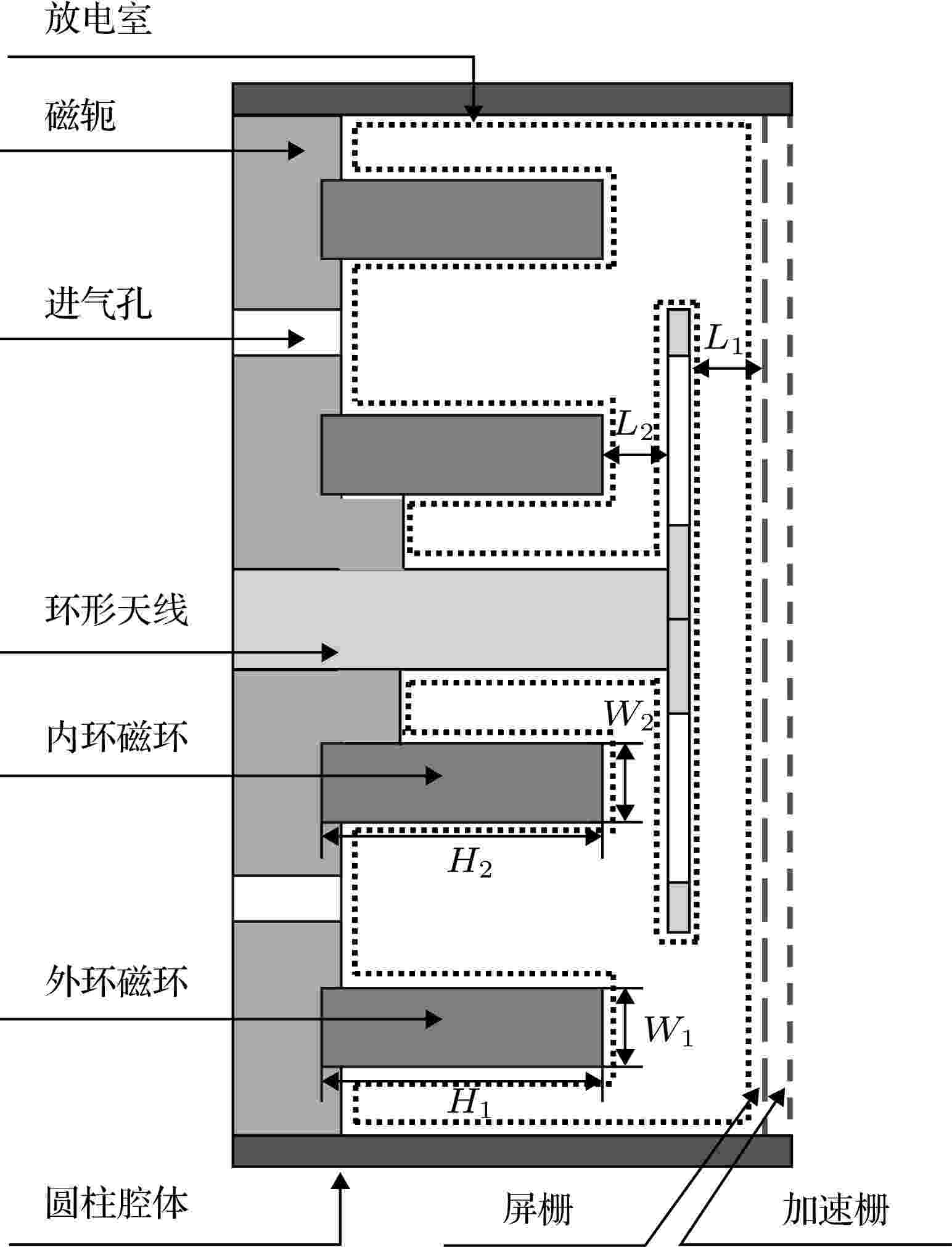
2019, 68 (23): 235202.
doi: 10.7498/aps.68.20191122
Abstract +
The advantages of miniature electron cyclotron resonance ion thruster (ECRIT) for space propulsion are long-life and simple-structure. The magnetic circuit and antenna position of ECRIT are crucial in the electron heating, plasma confinement and transportation process, which affect the beam extraction and the coupling voltage of neutralizer. In this article, the experimental studies on the ion beam extraction and coupling voltage of 2 cm ECRIT with different magnetic circuits and antenna positions are carried out. By comparing the beam extraction characteristics of the ion source and neutralizer of different magnetic circuits, a reasonable magnetic circuit structure is selected. And the influences of different antenna positions on the beam are compared. The influences of the magnetic circuit and antenna position on the performance of ECRIT are summarized to obtain a reasonable thruster structure. The experimental results show that the extracted beam increases with microwave power and xenon mass flow rate increasing. When the spatial position of antenna is fixed, a suitable magnetic circuit structure can increase electron heating and reduce particle loss, which is suitable for extracting ions and reducing the coupling voltage. With a suitable magnetic circuit, there is a suitable antenna position favourable for extracting ions and reducing the coupling voltage. According to the experimental results, the optimal structure of ion source and neutralizer are selected for neutralization experiments. The results show that when the neutralizer works, the beam extraction of the ion source is affected very little. When the neutralizer and ion source operate under the parameters of power and mass flow rate, respectively, of 1 W and 0.1 sccm (1 sccm = 1 mL/min), and also 2 W and 0.3 sccm, the thruster can operate coordinately to generate an ion beam of 5.3 mA, a discharge loss of 337.5 W/A, propellant utilization efficiency of 24.7%, thrust force of 368.6 μN, thrust specific impulse of 1277.6 s, and neutralizer coupling voltage of 17.4 V. The results can conduce to understanding the mechanism of the thruster and thus providing a reference for its design and performance optimization.
CONDENSED MATTER: ELECTRONIC STRUCTURE, ELECTRICAL, MAGNETIC, AND OPTICAL PROPERTIES

2019, 68 (23): 237301.
doi: 10.7498/aps.68.20191068
Abstract +
Filter is the core communication device in optical integrated chip. In recent years, plasma-induced transparency in surface plasmon (SPP) subwavelength waveguide photonic deviceshas become a research hotspot in the field of nano optics. The plasmon-induced transparency (PIT) is a phenomenon that the original absorption region produces a sharp transparent window due to the interaction among different resonant modes of SPPs, therefore, a higher resolution and quality factor surface plasmons can be obtained by using this feature to design a metal-medium-metal (MIM) waveguide structure filter. However, due to the Ohmic loss caused by metal parts, further research is needed on how to effectively improve transmission efficiency and achieve better frequency selection and filtering effect while reducing filter bandwidth in MIM waveguide filter. Based on the transmission and coupling characteristics of SPPs, an MIM waveguide filter with semi-closed T-waveguide side coupled disc cavity is proposed.Its transmission characteristics are studied by using the finite element method. The results show that a narrow-band transmission peak based on plasma-induced transparency appears in the transmission spectrum. Through theoretical analysis and mode field distribution, the physical mechanism of generating the PIT transparent peak and valley values on both sides is effectively explained. Compared with the traditional straight waveguide structure, the curved waveguide structure can generate the bilateral coupling effect, which can make resonant interaction stronger. Meanwhile, the numerical study shows that the approximately linear adjustment of filter wavelength can be achieved by changing the length of branches, the radius of the disk cavity and the refractive index of the medium in the cavity through external modulation. Further, the gain medium is embedded in the disk cavity, which enhances its local ability to emit light, strengthens the mode resonance effect, and realizes the compression filter pass-band bandwidth while effectively improving the structural transmittance, compared with similar filters. The research results provide an effective theoretical reference for designing the high resolution narrowband filter.
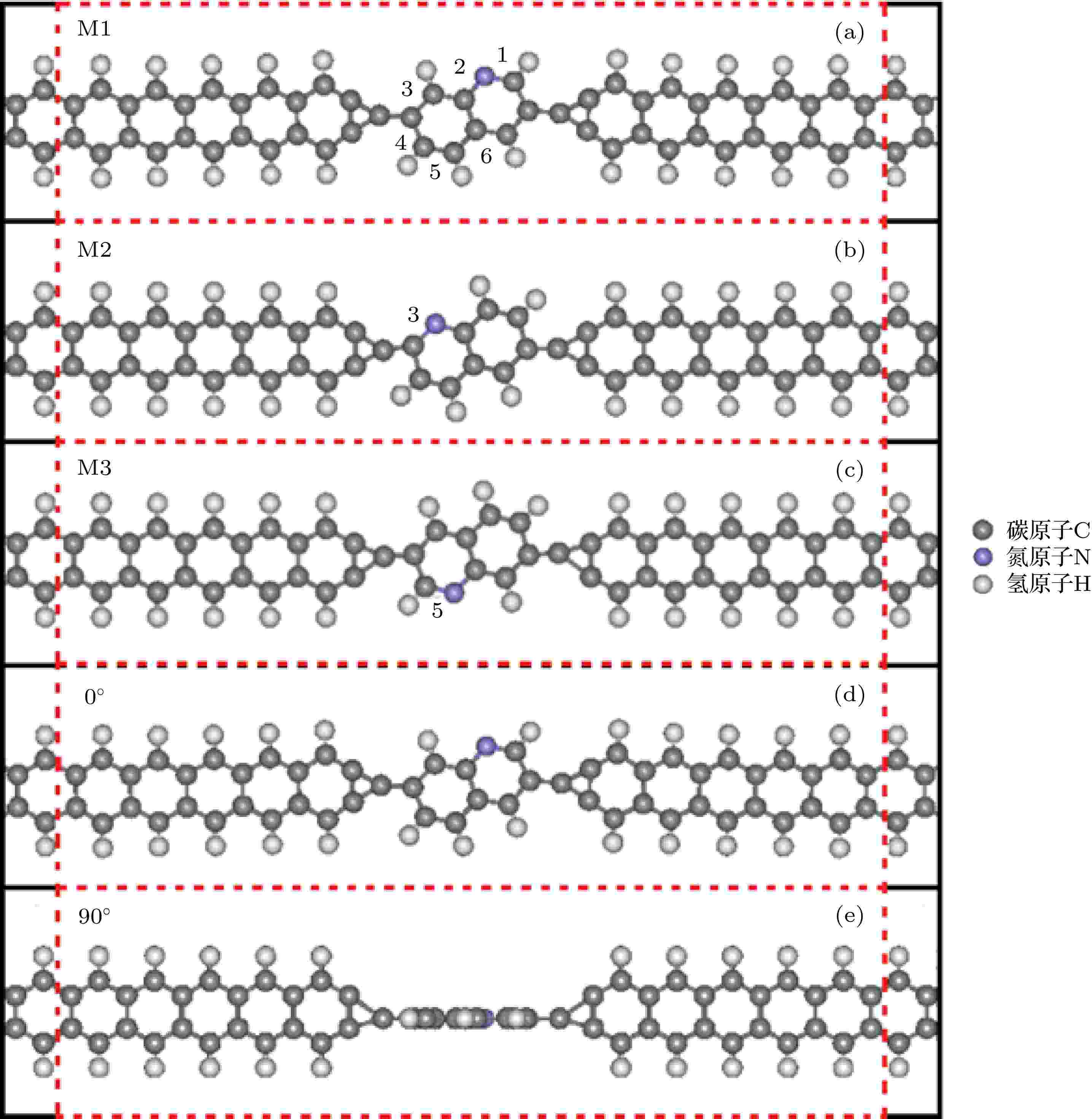
2019, 68 (23): 237302.
doi: 10.7498/aps.68.20191154
Abstract +
Since graphene was successfully obtained in the end of 2004, the research on graphene and relevant devices has attracted extensive attention. The armchair- and zigzag-edge graphene nanoribbons, as the building blocks, are often used to design the graphene-based molecular electronic devices. Quinoline, an important intermediate between metallurgical dyes and polymers, is an organic conjugated small molecule which is simple in structure and easy to synthesize and modify the chemical structure, and quinoline has become one of the research focuses in the field of molecular electronic devices in recent years. From the physical point of view, the transport properties of the isomeric quinoline molecular electronic devices connected with graphene nanoribbon electrodes can provide a theoretical basis for designing and manufacturing molecular electronic devices with excellent performance. Based on the first-principles calculation method combining the density functional theory and non-equilibrium Green's function, this paper systematically investigates the transport properties of the carbon-linked isomeric quinoline molecule electronic devices sandwiched between the graphene nanoribbon electrodes. The obtained results show that the device current presents a linear change in a bias voltage range [–0.3 V, +0.3 V], the current decreases with the increase of the absolute bias voltage, separately, in a range of [+0.5 V, +0.8 V] and [–0.4 V, –0.9 V], demonstrating a strong negative differential resistance effect. On the other hand, the interesting negative differential resistance effect is remained when there is an angle between the quinoline molecular plane and the graphene nanoribbon electrode; the current of the device is found to be independent of the rotation direction of quinoline molecule in the central region; the current of the device should be forbidden when the quinoline molecule plane is rotated to a direction vertical to the graphene nanoribbon electrodes. The obtained results can provide a theoretical basis for designing and manufacturing the molecular switches and negative differential resistance devices based on isomeric quinoline molecular electronic devices.
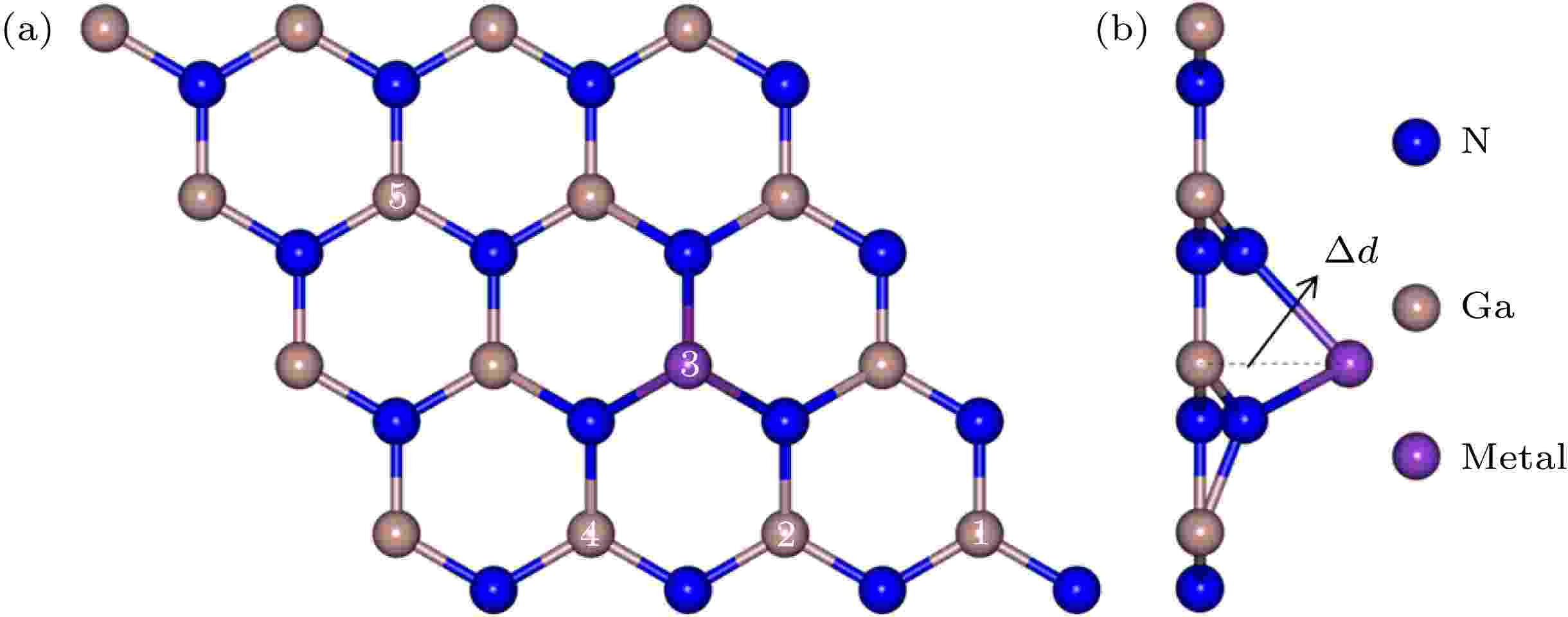
2019, 68 (23): 237303.
doi: 10.7498/aps.68.20191246
Abstract +
We systematically study the electronic structure and magnetic properties of alkali metals (Li, Na, K and Rb) and alkaline earth metals (Be, Mg and Sr) doped two-dimensional GaN monolayers using the first-principles calculations based on density functional theory. The results show that Be atom is located in the plane of the GaN monolayer, and the other doped atoms reside slightly above the plane. It is found that doping is easier to achieve under the N-rich condition. The total magnetic moment of the alkali metals doped system and the alkaline earth metals doped system are 2μB and 1μB, respectively, which are presented mainly by the spin-polarized holes of the nearest N atoms of the impurity atoms. The band structures indicate that the four alkali metal atoms doped systems are magnetic semiconductors, and the three alkaline earth metal doped systems are all semi-metallic. For a double M-doped GaN monolayer system, there is a long-range ferromagnetic coupling in the seven elements doped systems, which are realized by the hole-mediated p-p hybrid interaction. The Heisenberg mean field model is used to estimate the Curie temperature. It is found that the long-range ferromagnetic coupling states of Li, Be, Mg and Sr are existent at higher than room temperature, indicating that the four atom-doped two-dimensional GaN monolayers are very good candidates for the room temperature ferromagnetic candidate materials. The alkali metals and alkaline earth metals doped two-dimensional GaN monolayers are expected to play an important role in the studying of spintronics.
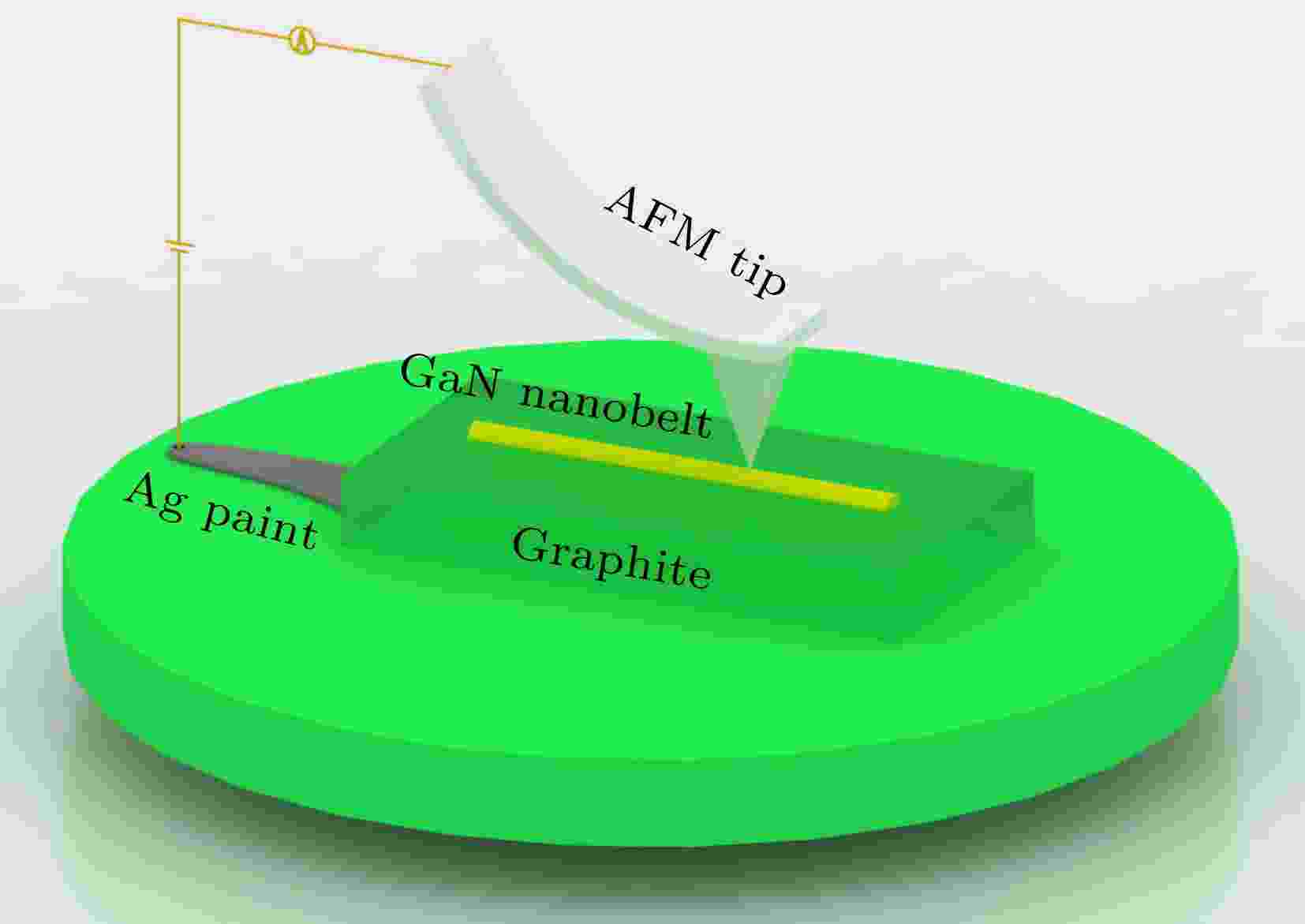
2019, 68 (23): 237304.
doi: 10.7498/aps.68.20191097
Abstract +
Gallium nitride (GaN) nanobelt with a quasi-one-dimensional structure possesses good piezoelectric and photoelectric properties. In this paper, the electromechanical coupling properties of single GaN nanobelt under optical modulation are studied by conductive atomic force microscope. The GaN nanobelts with good crystallization are prepared by the chemical vapor deposition method, then they are ultrasonically dispersed on a highly oriented pyrolysis graphite substrate. The conductive probe is used as a microelectrode to construct the two-terminal piezoelectric device based on a single GaN nanobelt, which has good electromechanical coupling performance. By changing the loading force of the probe and introducing an external light source to regulate the current transport properties of GaN nanobelt, the coupling between mechanical and semiconducting properties under light modulating is studied. It is found that the coupling between mechanical and semiconducting performance of the single GaN nanobelt can be effectively modulated by an external light source, and the electromechanical switch ratio of the single GaN nanobelt increases obviously in the presence of light. With the loading force increasing, the current response of the single GaN nanobelt increases but the rectification characteristics decrease. Finally, the experimental results are explained by the piezoelectric electronics and photoconductivity theory. This work is expected to provide a scientific basis for the performance modulation of nano-piezoelectric optoelectronic devices based on low-dimensional GaN nanomaterials.

2019, 68 (23): 237801.
doi: 10.7498/aps.68.20191121
Abstract +
Molybdenum disulfide (MoS2), as a layered transition metal chalcogenide, plays an important role in fields of photonics and photoelectronics. Here, a coupled system consisting of monlayer MoS2 and nano-resonator is designed and implemented. The photoluminescence (PL) spectrum of the MoS2 is coupled with the resonant mode of plasmonic bowtie resonator, thus achieving an optimal PL enhancement condition. Based on the analysis of theoretical model and experimental data, the spontaneous emission rate can be controlled by the Purcell effect, and the broadband enhanced spectrum is obtained in which its peak value increases 9.5 times and bandwidth is 100 nm . Meanwhile, the enhanced PL intensity also satisfies the cosine function relation between the polarization angle of the exciting light and that of the detecting light, which proves that the resonance mode comes from the electric field dipole in the resonator. This study provides the feasibility of studying the enhancement of light-matter interaction in an MoS2-plasmonic resonator coupled structure, which opens up a new route to improving the emission and detection efficiency of MoS2-based photonic devices in future.
INTERDISCIPLINARY PHYSICS AND RELATED AREAS OF SCIENCE AND TECHNOLOGY

2019, 68 (23): 238101.
doi: 10.7498/aps.68.20191055
Abstract +
The electromagnetic wave with spiral wavefront is a vortex beam carrying orbital angular momentum. The phase singularity of the vortex beam has special applications in the fields of particle manipulation and communication. In this paper, a terahertz (THz) wide-band vortex beam generator based on reflective metasurface is proposed and simulated. The device consists of a metasurface-dielectric-metal three-layer structure, and the top layer is a metasurface composed of two orthogonal I-shaped metal structural units. The intermediate layer of polyimide medium, and the bottom layer is of metal as a reflecting plate. The CST microwave studio is used to simulate the reflection performance of unit cell. The structure parameters are optimized to obtain the better performance. A set of optimed structure parameters is determined. According to the phase principle of Pancharatnam-Berry (P-B), by rotating the angle of the top-layer I-type metal structure, the reflection amplitudes of the unit cell structure at different rotation angles are required to approximately equal while the phase changes linearly with rotation angle and reaches a range of 2lπ for the topological charge number l. These cell structures are arranged according to the phase principle mentioned above. The metasurfaces of different topological charge numbers are designed to generate the corresponding vortex beams. In this paper, the metasurfaces with topological charge numbers 1 and 2 are designed. The reflection amplitude and phase of the circularly polarized THz beam incident vertically on the metasurface are simulated by using CST microwave studio. The simulation results show that in a frequency range of 0.8−1.4 THz, the metasurface can convert the circularly polarized terahertz beam into a vortex beam with a different topological charge number. In addition, in order to illustrate that the metasurface designed can produce a higher topological charge number of vortex beam, a metasurface with a topological charge number of 3 is designed as an example. The reflection amplitude and phase of the circularly polarized THz beam at a frequency of 1.1 THz is simulated. The results show that the designed metasurface can produce a vortex beam with a topological charge number of 3. The higher topological charges of vortex beam can also be generated according to the corresponding phase arrangement. The device has a relatively wide operating bandwidth, simple structure, high conversion efficiency, and has the potential application in terahertz vortex beam generation.
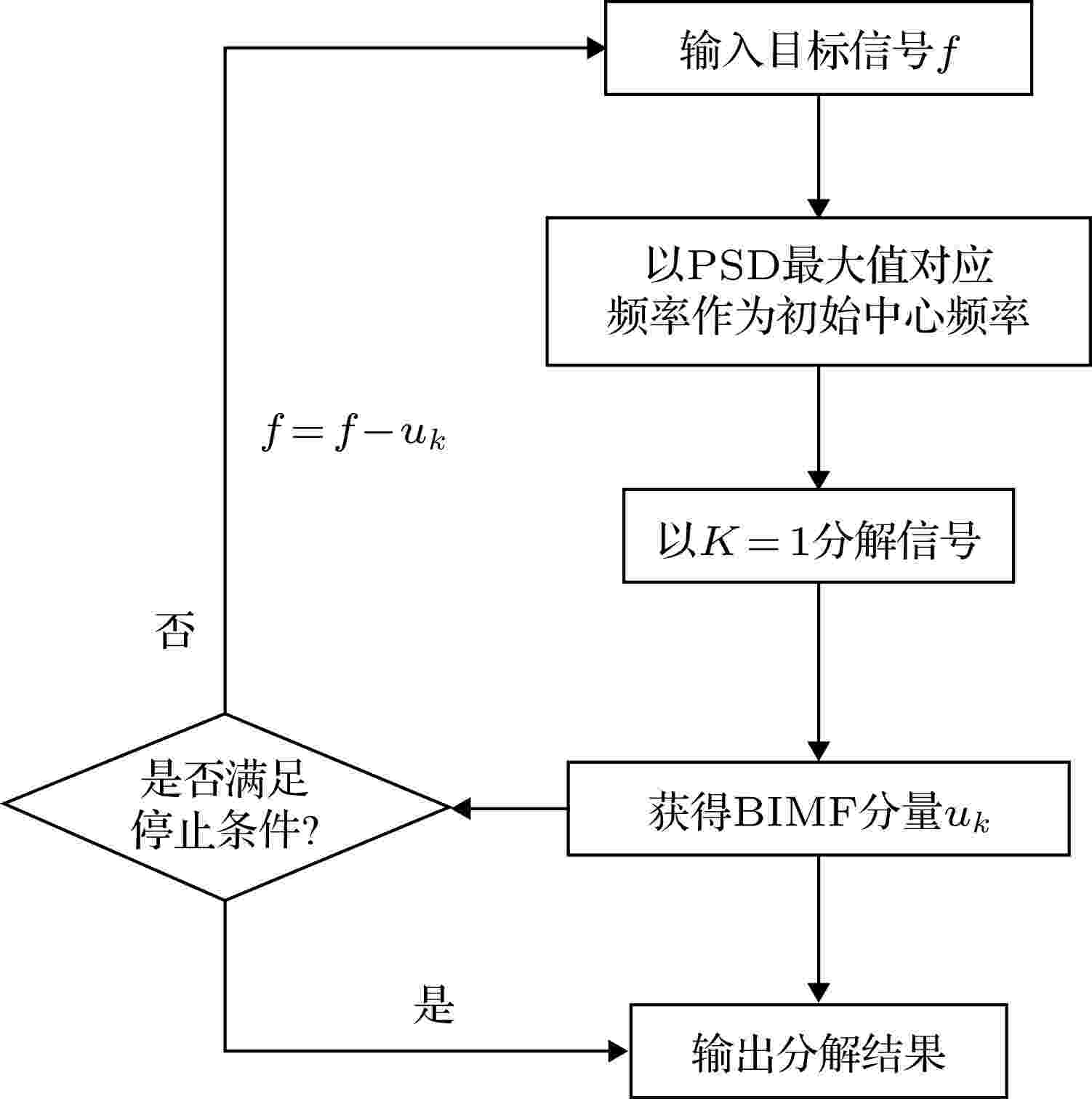
2019, 68 (23): 238401.
doi: 10.7498/aps.68.20191005
Abstract +
Variational mode decomposition can improve traditional recursive algorithms, such as empirical mode decomposition, resulting modal aliasing and endpoint effects, but it has a significant influence on signal decomposition accuracy due to its pre-set parameters. The frequency corresponding to the peak value of the target signal power spectrum is proposed to initialize the center frequency required for the variational mode decomposition. The empirical mode decomposition and recursive model is used to improve the variational mode decomposition into the recursive mode algorithm based on the energy cutoff method. The group optimization algorithm optimally takes the penalty factor with bandwidth constraint ability to form an optimized recursive variational mode decomposition. By comparing with and analyzing empirical mode decomposition, integrating empirical mode decomposition and optimizing the computational accuracy of recursive variational mode decomposition in decomposing signals; studying traditional variational mode decomposition and optimizing recursive variational mode decomposition in dealing with actual vibration signals calculating rate, the results are obtained, showing that the optimized recursive variational mode decomposition has the highest accuracy when dealing with the target signal, and the correlation with the original component is 99.9%. Comparing with the integrated empirical mode decomposition, the signal can be decomposed into different frequency bands from low to high, and the physical meaning is clearer. No false modality is generated. When the actual nonlinear signal is processed, the optimized recursive variational mode decomposition does not need to preset the number of decomposition modes, and the calculation rate is 12.5%–18.5% higher than thay of the traditional variational mode decomposition.
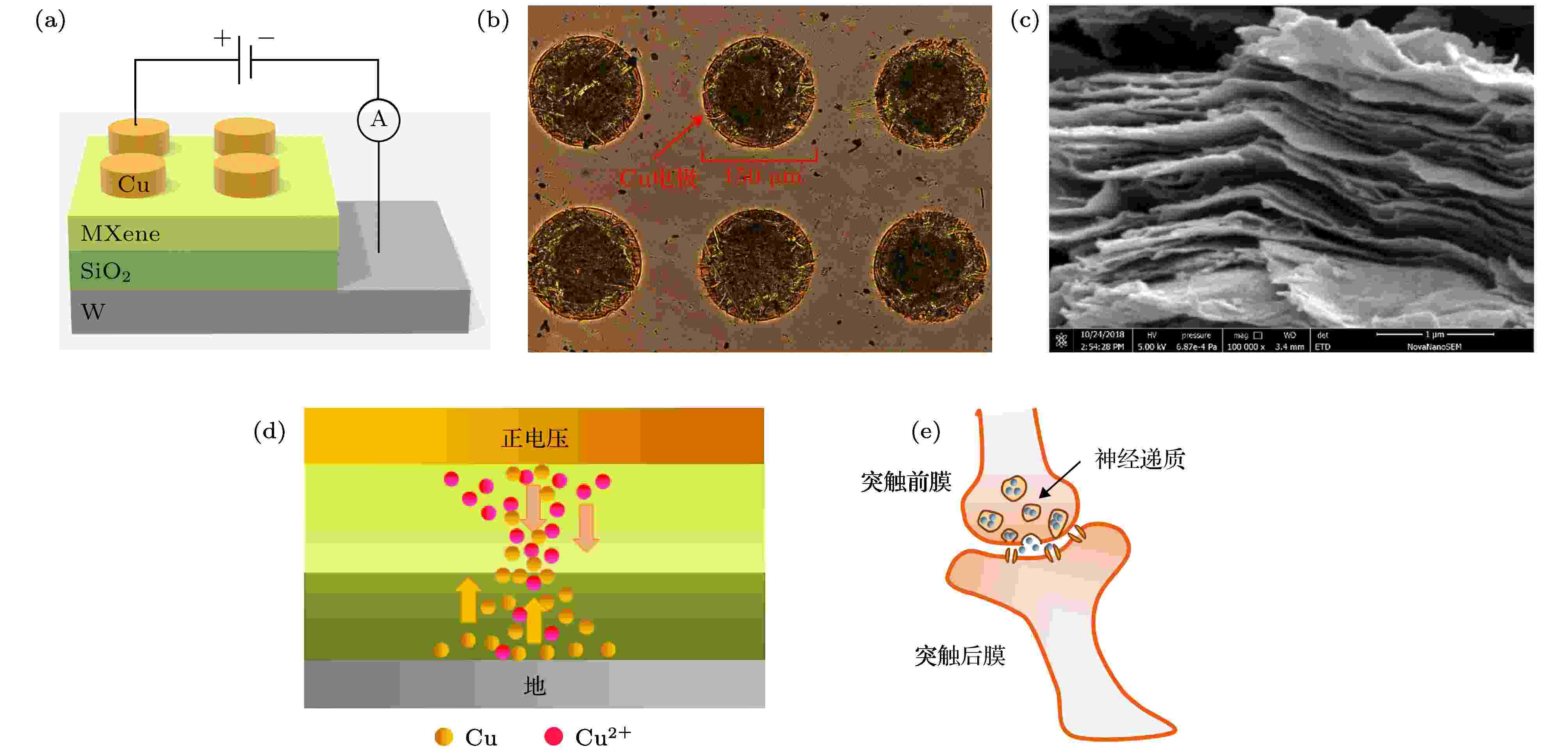
2019, 68 (23): 238501.
doi: 10.7498/aps.68.20191023
Abstract +
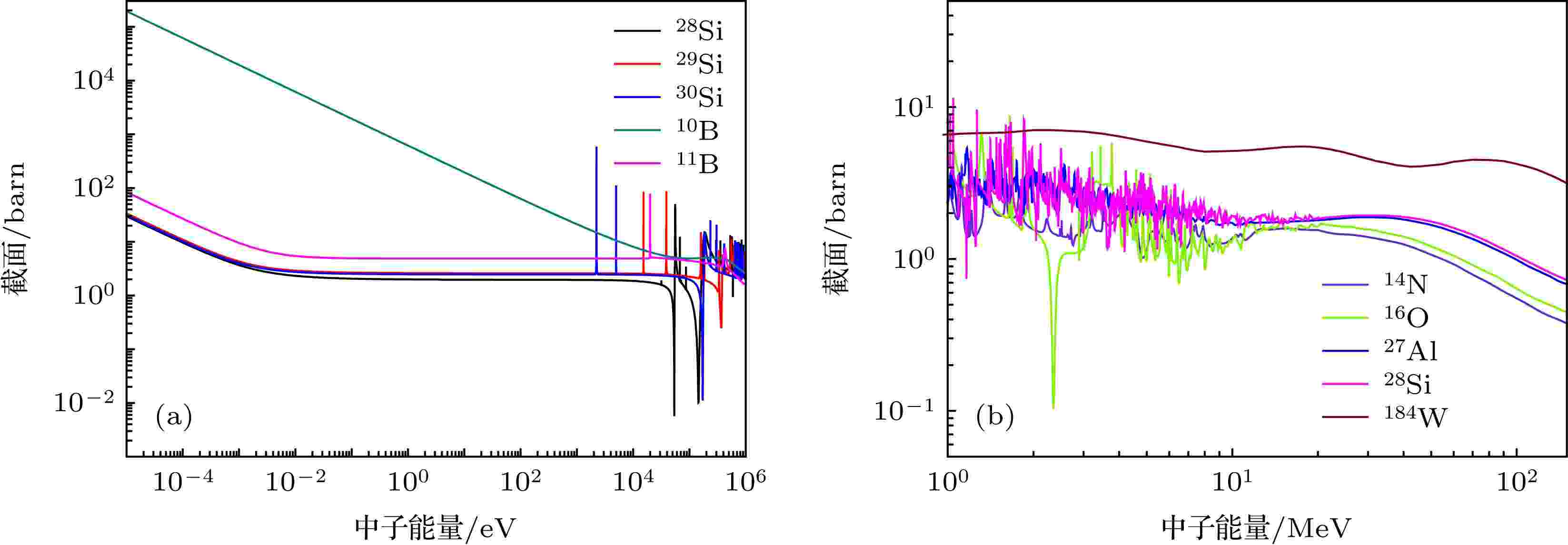
2019, 68 (23): 238502.
doi: 10.7498/aps.68.20191196
Abstract +
The 65 nm-microcontroller units (MCUs) are being widely used in critical terrestrial tests, and the risk from atmospheric neutron becomes more and more serious. The spallation neutron source contains broad energy spectrum, which is different from the mono-energetic neutron sources, and is the most ideal irradiation source for atmospheric neutron single event effect (SEE). Benefiting from China Spallation Neutron Source (CSNS), the atmospheric neutron SEE in 65 nm-MCUs is tested for the first time at the CSNS 9th beam line in China. The beam line is locatedin the 46° direction along the proton hitting the target, and the neutron spectrum is achieved to range from meV to 1.6 GeV. The test is conducted in two conditions in order to investigate the influence of thermal neutron. One is that the thermal neutrons are shielded with a 2-mm-thick cadmium slat at the beam ejection hole, and the other is not. The detected effects are single bit upset (SBU) events. 16 SBU events are detected when 5.3363 × 1017 protons hit the tungsten target without the thermal neutron, and 63 SBU events are recorded in the condition of 7.2131 × 1017 protons striking the target and thermal neutrons included. Comparing with the high energy neutron (>1 MeV), the SBU events caused by thermal neutron contribute about 65% of the number of total upset events. The test results preliminarily illustrate that the thermal neutrons dominate the 65 nm MCU reliability.
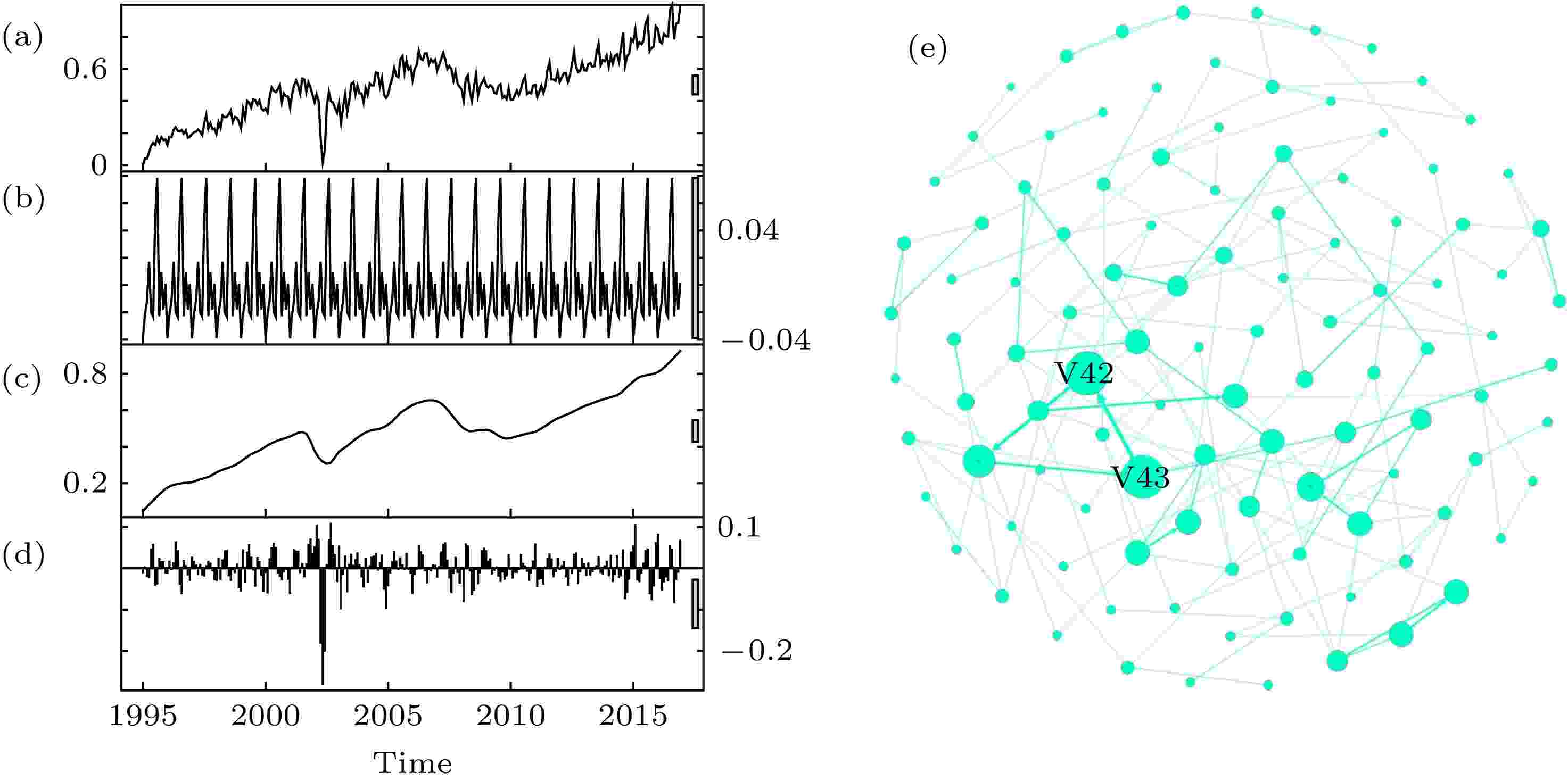
2019, 68 (23): 238901.
doi: 10.7498/aps.68.20190794
Abstract +
Modeling the time series complex network provides a new perspective for analyzing the time series. Some classical algorithms neglect the unidirectionality of the time and the difference in correlation between primitives. While the symbolized time series network can construct the network on a controlled scale and can construct the weighted directed network which is closer to reality. Combined with the seasonal-trend-loess method and the symbolized transformation of the periodic time series, a time series network construction method is proposed. Both the state of a single data value and the long-term trend of the time series are considered in our symbolized time series network. The symbolic modes are used as nodes, and the edges are defined according to the adjacent transformation relationship between nodes. The direction and the weight of the edges are determined according to the conversion direction and the conversion frequency. Then, the directed weighted network is established. The air passenger throughput time series and the Internet traffic time series are used as the experimental data respectively. The topological features of these two time series networks are obviously different. Furthermore, to mine the essential laws of time series data, the empirical analysis of the time series of mobile communication voices is carried out. Our work enriches the research results of time series networks.
Original Articles

2019, 68 (23): 239401.
doi: 10.7498/aps.68.20191252
Abstract +
















